#julian decrees
Explore tagged Tumblr posts
Note
Mosquito
I am many things, that is not one of them.
14 notes
·
View notes
Text














Milestone Monday
A Date with History
On this day, February 24, 1582, Pope Gregory XIII announced the Gregorian calendar with the papal bull (public decree) Inter gravissimas. The primary reason for this reform was to address the calendar's drift concerning the equinoxes and solstices.
Before the Gregorian calendar, the Julian calendar, introduced by Julius Caesar in 46 BC, counted a year as 365.25 days, with an extra day added every four years for leap years. However, this calculation was slightly off, leading to a cumulative drift of approximately 11 minutes per year. By the 16th century, the calendar had drifted significantly; the spring equinox had moved from March 21 to around March 11. Pope Gregory XIII decided to implement a reform to realign the calendar with the seasons.
The Gregorian calendar was first implemented in October 1582 in Catholic countries such as Italy, Spain, Portugal, Austria, and Poland. The day after October 4, 1582, became October 15, 1582, skipping 10 days to correct the drift. At first, Protestant and Orthodox nations refused to adopt it, unwilling to follow the Pope's direction. This most certainly caused problems and headaches, to be sure! Consequently, crossing a border meant traveling backward and forward on a calendar. Talk about time travel. That’s enough to make Marty McFly’s head spin!
Others were also slow to join the party. Great Britain and its colonies transitioned in 1752, skipping 11 days (September 2 was succeeded by September 14). Russia did not adopt the calendar until 1918, following the Bolshevik Revolution, which led to the calendar change that year, where January 31 was succeeded by February 14. However, over the following centuries, the Gregorian calendar became the worldwide standard, and today, it is widely used for civil purposes.
The featured images come from:
Wisconsin Artists Calendar published in Milwaukee, WI by Wisconsin Printmakers, 1936.
A Calendar: Twelve Poems by Robert Creeley. It was published in West Branch, Iowa byCoffee House Press, 1984.
Wisconsin Poets' Calendar published in Fairwater, WI by Midwestern Writers' Publishing House, 1983.
The Cynic's Calendar of Revised Wisdom for 1904 by Oliver Herford, Ethel Watts Mumford, and Addison Mizner. It was published in San Francisco by Paul Elder and Company, 1903.
-View more Milestone Monday posts
--Melissa, Special Collections Library Assistant
#Milestone Monday#milestones#gregorian calendar#julian calendar#Pope Gregory XIII#papal bull#calendar#A Calendar Twelve Poems#Robert Creeley#Coffee House Press#Wisconsin artists calendar#Wisconsin Printmakers#Wisconsin poets' calendar#Midwestern Writers' Publishing House#The Cynic's Calendar of Revised Wisdom for 1904#Oliver Herford#Ethel Watts Mumford#Addison Mizner#Paul Elder and Company#history dates#date with history
51 notes
·
View notes
Text
First time trying to come up with an idea in the Omegaverse.
Jaskier is considered rare among Omega for several reasons, which sets him apart from the norm. Firstly, he is a male Omega, a rarity in itself, as male Omegas are not very common. Due to their scarcity, male Omegas have often been treated as precious gems, valued for their uniqueness. Jaskier's gender alone makes him stand out among his peers.
Moreover, Jaskier possesses qualities that deviate from the stereotypical traits associated with Omega individuals. He is known for being headstrong and exceptionally talkative, which contrasts with the expected demeanor of a docile and reserved Omega
Interestingly, all the qualities that make Jaskier different from other Omegas are the very reasons why Geralt is deeply enamored with him. As an alpha, Geralt is often seen as the epitome of Alpha characteristics, except for the fact that he is a Witcher. The Witcher mutations have bestowed upon Geralt the genetic traits of an alpha, making him a unique blend of both human and monster.
Despite their individual oddities, Geralt and Jaskier have formed a remarkable bond as mates
One day, Jaskier woke up feeling unwell, experiencing bouts of morning sickness. Concerned for his mate's well-being, Geralt decided to take Jaskier to see Yennefer. Little did they know, Yennefer had a surprising revelation waiting for them—by some miraculous twist of fate, Jaskier was pregnant.
Given that witchers were believed to be sterile, Geralt never anticipated the possibility of Jaskier becoming pregnant. Nevertheless, Jaskier was content with the idea, considering his life as a traveling bard made it challenging to raise a child. However, Yennefer believed that destiny had played a hand in this situation, decreeing that Geralt and Jaskier should embrace their roles as parents.
Geralt and Jaskier experienced a mixture of nerves and excitement at the prospect of becoming parents. However, their joy was short-lived as they soon discovered the alarming truth—numerous individuals were relentlessly pursuing their unborn baby
In this unprecedented occurrence of a witcher baby, the belief spread that the child would possess unparalleled power, surpassing any known beings. A group with nefarious intentions devised a plan to kidnap Jaskier, intending to hold him captive until the baby was born and subsequently raise the child as their new leader. They were even prepared to eliminate Jaskier if he refused to comply with their demands after the baby's birth.
Before assuming the name Jaskier, he was known as Julian Alfred Pankratz, Viscount de Lettenhove. Jaskier had fled his home to escape the clutches of his controlling parents, who, despite hearing about Jaskier's pregnancy, adamantly refused to recognize Geralt as his mate. Jaskier's parents harbored intentions of arranging a marriage between him and a wealthy Alpha Lord, solely for the sake of social status and riches.
Moreover, the kingdom of Nilfgaard, in their ongoing efforts to coerce Ciri, Geralt's child surprise , into their grasp, recognized Jaskier as a potential bargaining chip. Consequently, their interest in capturing Jaskier intensified, surpassing their previous pursuits.
Now on the run, desperate to ensure the safety of their unborn child, Geralt is willing to go to any lengths to protect his beloved Jaskier. Together, they make their way towards Kaer Morhen, seeking refuge and the support of the other witchers.
However, the magical nature of the baby begins to pose problems. Jaskier's pregnancy progresses at an astonishing rate, with his belly growing larger by the day, making their arduous journey even more challenging. Walking becomes a struggle with Jaskier's prominent pregnant belly, and the fact that he is a male omega further complicates their ability to hide and remain inconspicuous.
To add to their concerns, it is discovered that the baby carries witcher mutations in its genes. As Jaskier's health deteriorates, Geralt's fears intensify, dreading the possibility that Jaskier may not survive the process of giving birth to a witcher child
#the witcher netflix#joey batey#jaskier the witcher#geralt of rivia#the witcher#henry cavill#the witcher jaskier#geralt x jaskier#geraskier#fic ideas#jaskier#cirilla fiona elen riannon#freya allan#gerskier#yennefer of vengerberg#anya cholatra#anya chalotra#the witcher season 3#omegaverse#Omega Jaskier#Alpha Geralt
154 notes
·
View notes
Text
"aloha rodeo" by david wolman and julian smith is a great book about a slice of history I didn't even know existed until I read it, the Hawaiian cowboy. I knew there was ranching in Hawaii but I had no idea that it traced back to captain vancouver (guy they named the city after) giving longhorns to king kamehameha i in 1793. vancouver impressed upon him that he needed to build up his herd so he issued a royal decree banning anyone from killing the cattle and by the time of king kamehameha iii there were just cattle running wild all over the island. he hired some vaqueros to teach Hawaiians how to rope cattle and the paniolo was born (paniolo started as a nickname for Spaniard). so this book argues that Hawaiian cattle ranching predates the widespread ranches of the American west, though it also grew from techniques used first in Spanish-controlled territory
paniolo used saddles made of wood and rawhide, bc Hawaiians had plenty of experience carving wood to sit on (boats) and leather saddles were not suitable for the climate. or for the final step of the paniolo's journey: driving cattle into the ocean on horseback and then climbing from the horse to the cow to attach a harness so it could be lifted onto a boat. they were incredibly skilled and in 1908 three guys had the chance to show their ability to mainlanders at the frontier days rodeo in cheyenne. so the book also talks about the city of cheyenne, what buffalo bill was up to, the intersection of the Wild West with the rodeo as a spectacle, etc
honestly a pretty fast read for nonfiction and a really fascinating snapshot of Hawaiian and American history
13 notes
·
View notes
Text
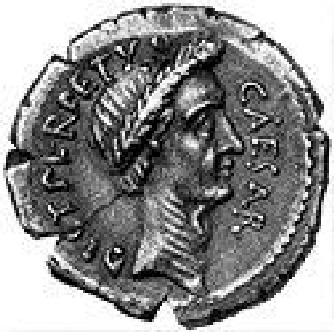
Julius Caesar and Leap Days - February 29th, 1996.
"Today, February 29th, is a leap day - a relatively rare occurrence. Advised by Alexandrian astronomer Sosigenes, Roman dictator Julius Caesar, pictured above in a self-decreed minted coin, created a calender system in 46 BC that contained one leap day every four years. The reason for adding leap days was that a year - defined by the time it takes the Earth to circle the Sun - does not actually take an exact integer number of days - defined by the time it takes for the Earth to rotate once. In fact, one year by these astronomical definitions is about 365.24219 days. If all calendar years contained 365 days, they would drift from the actual year by about 1 day every 4 years. Eventually July (named posthumously for Julius Caesar himself) would occur during the northern hemisphere winter! By making most years 365 days but every fourth year 366 days, the calendar year and the actual year remained more nearly in step. This "Julian" calender system was used until the year 1582, when Pope Gregory XIII added that leap days should not occur in years ending in "00" except if divisible by 400, providing a further fine tuning. This "Gregorian" calender system is the one in most common use today."
21 notes
·
View notes
Text

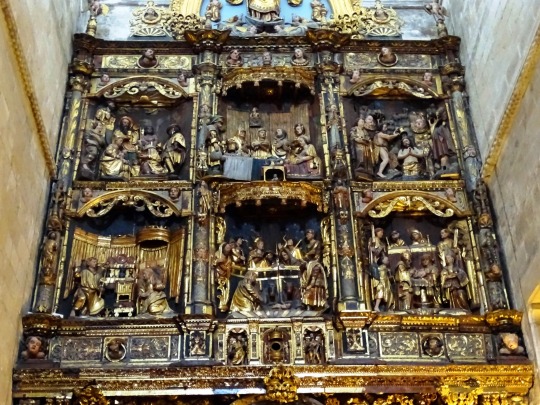




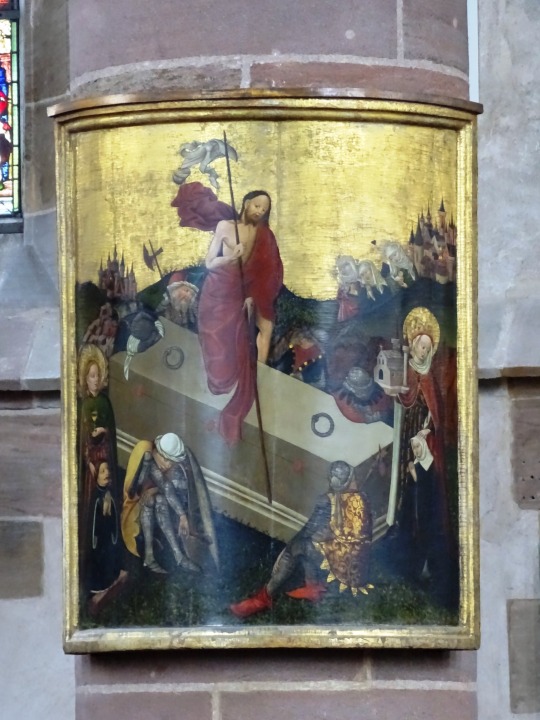


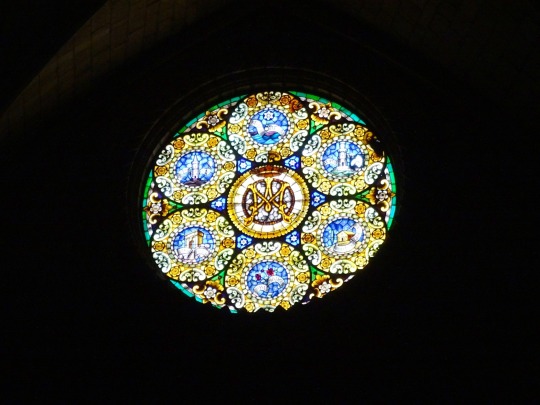

Ascension Day
We commemorate Jesus Christ’s ascension into heaven (as per Christian belief) by celebrating Ascension Day, which occurs on the Thursday, which is 40 (or 39) days after Easter. This year, it will take place on May 29. Known by multiple names — The Feast of the Ascension, The Ascension of Jesus, Ascension Thursday, Holy Thursday, or Solemnity of the Ascension of the Lord — this is a Christian holiday that doubles as a public holiday in many countries like Austria, Belgium, Denmark, Germany, France, Switzerland and more.
History of Ascension Day
One of the earliest Christian festivals, Ascension Day marks the end of the Easter season. This event is celebrated primarily by Catholics and Anglican Christians; most Protestant churches do not follow this tradition anymore. The date, too, differs in different geographic locations. Western Churches prefer to use the Gregorian calendar for calculating this date, while many Eastern Orthodox Churches calculate this date according to the Julian calendar. As a result, their celebrations occur at a later date than the Western event.
As per the New Testament in the Bible, after Jesus Christ’s crucifixion on Good Friday, he was resurrected from the dead in three days, on the day we know as Easter Sunday. For 40 days after this, he stayed with his Apostles (the primary disciples of Christ) to instruct them on how to carry out his teachings. As the Bible says, at the end of day 40, Jesus Christ and his disciples went to Mount Olivet (or the Mount of Olives), near Jerusalem. After asking them to stay, Christ then ascended to heaven to take his seat at the right hand of God, under the gaze of his disciples. To Christians, the ascension signifies that Christ completed his work on Earth and allowed him to prepare a place for his followers in heaven.
Initially a part of Easter celebrations, this day was later separated from Easter, along with Pentecost. Celebration of Pentecost ends the cycle of Easter-related events in the Christian calendar.
Ascension Day timeline
68 A.D. The Tradition Begins
Ascension Day begins to be observed, albeit with two other holidays — Easter Sunday and Pentecost.
300 A.D. Ascension Day Develops As A Separate Tradition
A decree declares this celebration now must be observed separately — it is moved to 40 days after Easter.
385 A.D. First Written Evidence Appears
We see the very first piece of written evidence that the Ascension Day Feast is celebrated.
5th century Ascension Day Starts Appearing In Art
Christian art showcases this holiday.
6th century Art Begins To Reflect Different Versions
Syria develops a different version of the Ascension, which is later adopted by Byzantine art.
18th century Germany Celebrates Father's Day
Ascension Day coincides with Father's Day in Germany — they celebrate Jesus returning to the Holy Father.
19th century Germany Celebrates With Colourful Parades
To replicate the way the Apostles walked with Jesus, Christians begin to host colorful parades as a commemoration.
How To Observe Ascension Day
Go to church
Attend church processions
Listen to hymns
Learn how your local church celebrates this day. Take some time to attend a Mass or Christian church service. Clarify the details before you go, as these services differ based on whether the church is Protestant or Catholic.
Tradition says this holiday is observed by a three-day procession, then the feast itself, which includes a procession of torches and banners to symbolize Christ’s journey to the Mount of Olives and entry into heaven. While your local church might not have such grand festivities, find out if they are still carrying out a procession.
Listening to hymns is a traditional part of Ascension Day celebrations. A medley of these religious songs can have you humming along for days. Even popular artists have been known to hum a hymn or two over the years. Check out Carrie Underwood’s ‘Something In The Water,’ or U2’s ‘Where The Streets Have No Name,’ or even John Legend’s ‘Preach.’
Facts About Ascension Day
In Sweden, people go on early morning walks
The British celebrated by 'beating the willow'
Welsh people don’t work on this day
Portugal celebrates by keeping wheat in their houses
Indonesia has a public holiday on Ascension Day
Many people go out into the woods at 3 AM or 4 AM to hear the birds at sunrise, believing that hearing a cuckoo from the east or west brings them good luck — this activity is called ‘gökotta.’
In the olden days, as young boys were driven along the parish boundaries, they were beaten with willow branches to drive away evil.
It is more than a holiday celebration in Wales — Welsh people believe that it is unlucky to do any work on Ascension Day.
Traditionally, rural Portuguese households keep wheat in their homes throughout the coming year — this day is associated with peace and prosperity and, to them, wheat symbolizes prosperity.
Despite Christianity being a minor religion in Indonesia, Ascension Day is designated as a public holiday.
Why Ascension Day Is Important
It is an opportunity for reflection and to gain inner peace
We learn about Christian traditions
It helps us expand our cultural horizons
Instances, where we can simply sit, reflect, and learn the true meaning of peace, are rare in our busy worlds. This is why we recommend holding onto such chances with both hands. Ascension Day church services center around this theme. If you are not a religious or church person, simply take a moment to sit by yourself and reflect on your journey so far and how you would like to continue. There’s no better way to celebrate this day than by centering yourself and your thoughts.
Expanding our knowledge is good for us. Plus, learning about Ascension Day not only helps us expand our store of general knowledge, but also inspires us to observe some of the traditions.
Such traditions have been prevalent for a long time, and have taken on varying degrees of importance around the world. Even festivities change as per the customs of a certain region. Learning more about these traditions changes our views of cultures and gives us extended knowledge of people from other nations.
Source
#Mojácar Pueblo#Church of Santa Maria#Lisbon Cathedral#stained glass window#Ascension Day#Auffahrt#long weekend#29 May 2025#39 days after Easter#Saint Mary's Cathedral#Lugo Cathedral#Spain#Portugal#Holy Trinity Anglican Cathedral#Québec#Canada#Germany#Stadtpfarrkirche Unserer Lieben Frau#Nuremberg#Nürnberg#Solsona Cathedral#St. Patrick's Cathedral#New York City#USA#architecture#original photography#travel#vacation#tourist attraction
3 notes
·
View notes
Text
About Lucia

Going by the old Julian calendar, December 13 was the darkest night of the year — the eve of the winter solstice. This, however, changed after the calendar reformation in 1753, when the Gregorian calendar was put into use in Sweden, and the winter solstice shifted to December 21. But the folk tradition still stood — the night before the 13th was still popularly known as the darkest night, and therefore also the most dangerous, for the darkness allowed evil entities to thrive longer than any other night. This, in turn, has led to a number of traditions, but the most important aspect has always been the one of light and feasting. To keep the evil away, it was important to stay awake and to stay indoors with lights.
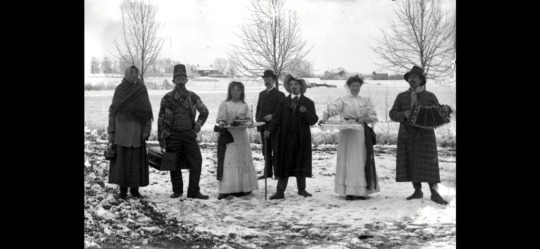
But to be able to stay awake a whole night, one must eat. Tradition decreed that almost all preparations for jól (the midwinter celebration) should also be completed by the 13th, including the slaughter of the festive pig, meaning there was fresh food prepared already and the long night served as a good reason to get an early start on the seasonal feasting. Sometimes, the teenagers and young adults would walk from neighbor to neighbor, singing songs in exchange for food and drink, protected with light. Sometimes they would dress up, and sometimes they would do some pranks to scare people.
Today, the tradition is still standing: to lussa is to dress up as Lucia and walk to neighbors or family members with song and cakes. However, the act of lussa was originally to stay awake during the night between the 12th and 13th and was called Lussevaka (Lusse watch). Lucia can still be equally called Lussefirande (Lusse celebration) today.
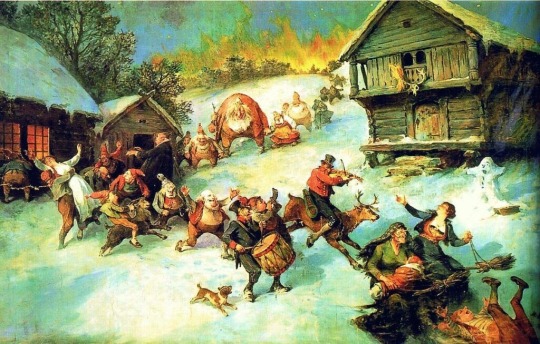
But why Lussa? Lussi, otherwise known as Lussekäringen (the Lussi witch) or Lussegubben (Lussi man), was an evil entity. She often took the form of a woman who came riding through the skies with her companions called lussifreda. She was one of the evil spirits who would lurk around in the night and take naughty children away through the chimneys, or punish those who had not completed their jól preparation.
And it is due to this, in the dark of the longest night with a despair for light, with evil all around, that the myth of a female figure of light arose. During the pre-Christian era, the light was sworn to keep evil away. The tradition of a light-bringing woman may therefore have its foundation in a heathen goddess of light who was invoked during this night. The tradition of celebrating light in this manner through Lussevaka has stayed on in different forms ever since.

There is also a theory that Lusse is Freya, hence the traditional bread called “lusse cats” would refer to the cats pulling her wagon.

Lusse bread is baked to honor Sunna (the sun) and attract it back when it was at its darkest, today's lusse cats still have the old Sunna symbols (the spirals at the ends).

In the 19th century, a special interest sparked in the Lusse celebration, due to the first wave of nationalism and the search for old folk traditions all around Sweden. Lusse, which was mainly celebrated by men or women dressing up in white with a crown of flowers, holding candlesticks and walking around the farm with food while singing in the morning, gave the foundation to the modern Lucia.
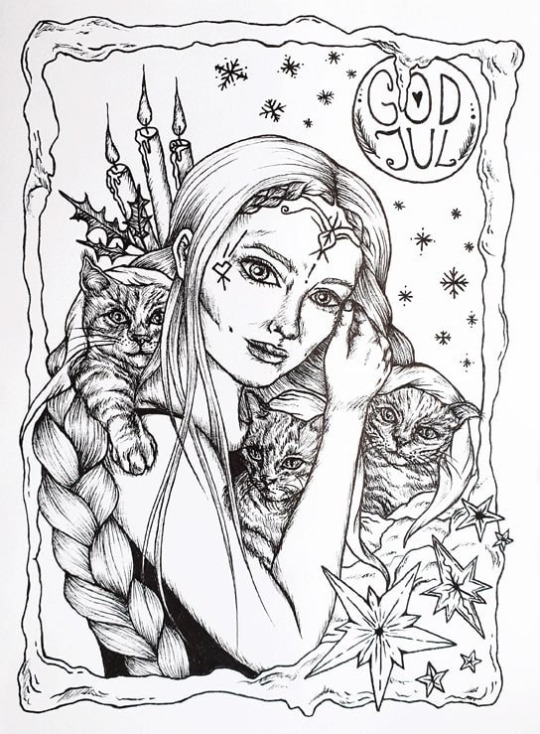
4 notes
·
View notes
Text
SAINTS&READING: MONDAY, MARCH 31, 2025
Fifth Week of the Great Lent. By Monastic Charter: Strict Fast (Bread, Vegetables, Fruits)
St CYRIL ARCHBISHOP OF JERUSALEM (386)

Saint Cyril, Archbishop of Jerusalem, was born in Jerusalem in the year 315 and was raised in strict Christian piety. Upon reaching the age of maturity, he became a monk, and in the year 346 he became a presbyter. In the year 350, upon the death of Archbishop Maximus, he succeeded him on the episcopal throne of Jerusalem.
As Patriarch of Jerusalem, Saint Cyril zealously fought against the heresies of Arius and Macedonius. In so doing, he aroused the animosity of the Arian bishops, who sought to have him deposed and banished from Jerusalem.
There was a miraculous portent in 351 at Jerusalem: at the third hour of the day on the Feast of Pentecost, the Holy Cross appeared in the heavens, shining with a radiant light. It stretched from Golgotha above the Mount of Olives. Saint Cyril reported this portent to the Arian emperor Constantius (351-363), hoping to convert him to Orthodoxy.
The heretic Acacius, deposed by the Council of Sardica, was formerly the Metropolitan of Caesarea, and he collaborated with the emperor to have Saint Cyril removed. An intense famine struck Jerusalem, and Saint Cyril expended all his wealth in charity. But since the famine did not abate, the saint pawned church utensils, and used the money to buy wheat for the starving. The saint’s enemies spread a scandalous rumor that they had seen a woman in the city dancing around in clerical garb. Taking advantage of this rumor, the heretics forcibly expelled the saint.
The saint found shelter with Bishop Silvanus in Tarsus. After this, a local Council was held at Seleucia, at which there were about 150 bishops, and among them Saint Cyril. The heretical Metropolitan Acacius did not want to allow him to take a seat, but the Council would not consent to this. Acacius stormed out of the Council, and before the emperor and the Arian patriarch Eudoxius, he denounced both the Council and Saint Cyril. The emperor had the saint imprisoned.
When the emperor Julian the Apostate (361-363) ascended the throne he repealed all the anti-Orthodox decrees of Constantius, seemingly out of piety. Saint Cyril returned to his own flock. But after a certain while, when Julian had become secure upon the throne, he openly apostasized and renounced Christ. He permitted the Jews to start rebuilding the Temple of Jerusalem that had been destroyed by the Romans, and he even provided them part of the funds for the building from the state treasury.
Saint Cyril predicted that the words of the Savior about the destruction of the Temple down to its very stones (Luke. 21:6) would undoubtedly transpire, and the blasphemous intent of Julian would come to naught. Soon there was such a powerful earthquake, that even the solidly set foundation of the ancient Temple of Solomon shifted in its place, and what had been rebuilt fell down and shattered into dust. When the Jews resumed construction, a fire came down from the heavens and destroyed the tools of the workmen. Great terror seized everyone. On the following night, the Sign of the Cross appeared on the clothing of the Jews, which they could not remove by any means.
After this heavenly confirmation of Saint Cyril’s prediction, they banished him again, and the bishop’s throne was occupied by Saint Cyriacus. But Saint Cyriacus soon suffered a martyr’s death (October 28).
After the emperor Julian perished in 363, Saint Cyril returned to his See, but during the reign of the emperor Valens (364-378) he was exiled for a third time. It was only under the holy emperor Saint Theodosius the Great (379-395) that he finally returned to his archpastoral activity. In 381 Saint Cyril participated in the Second Ecumenical Council, which condemned the heresy of Macedonius and affirmed the Nicea-Constantinople Symbol of Faith (Creed).
Saint Cyril’s works include twenty-three Instructions (Eighteen are Catechetical, intended for those preparing for Baptism, and five are for the newly-baptized) and two discourses on Gospel themes: “On the Paralytic,” and “Concerning the Transformation of Water into Wine at Cana.”
At the heart of the Catechetical Instructions is a detailed explanation of the Symbol of Faith. The saint suggests that a Christian should inscribe the Symbol of Faith upon “the tablets of the heart.”
“The articles of the Faith,” Saint Cyril teaches, “were not written through human cleverness, but they contain everything that is most important in all the Scriptures, in a single teaching of faith. Just as the mustard seed contains all its plethora of branches within its small kernel, so also does the Faith in its several declarations combine all the pious teachings of the Old and the New Testaments.”
Saint Cyril, a great ascetic and a champion of Orthodoxy, died in the year 386.
REPOSE OF St MARIA (SKOBTSOVA) OF PARIS (1945)

Elizaveta Pilenko, the future Mother Maria, was born in 1891 in Riga, Latvia, then part of the Russian Empire, and grew up in the south of Russia on the shore of the Black Sea. Her father was mayor of the town of Anapa, while on her mother's side, she was descended from the last governor of the Bastille, the Parisian prison destroyed during the French Revolution.
Her parents were devout Orthodox Christians whose faith helped shape their daughter's values, sensitivities and goals. As a child she once emptied her piggy bank in order to contribute to the painting of an icon that would be part of a new church in Anapa. At seven she asked her mother if she was old enough to become a nun, while a year later she sought permission to become a pilgrim who spends her life walking from shrine to shrine.
At the age of 14, her father died, an event that seemed to her meaningless and unjust and led her to embrace atheism. "If there is no justice," she said, "there is no God." She decided God's nonexistence was well known to adults but kept secret from children. For her, childhood was over. When her widowed mother moved the family to Saint Petersburg in 1906, she found herself in the country's political and cultural center — also a hotbed of radical ideas and groups — and became part of radical literary circles that gathered around such symbolist poets as Alexander Blok, whom she first met at age 15. Like many of her contemporaries, she was drawn to the left, but was often disappointed at the radicals she encountered. Though regarding themselves as revolutionaries, they seemed to do nothing but talk. "My spirit longed to engage in heroic feats, even to perish, to combat the injustice of the world," she recalled. Yet no one she knew was actually laying down his or her life for others. Should her friends hear of someone dying for the Revolution, she noted, "they will value it, approve or not approve, show understanding on a very high level, and discuss the night away till the sun rises and it's time for fried eggs. But they will not understand at all that to die for the Revolution means to feel a rope around one's neck."
In 1910, she married Dimitri Kuzmin-Karaviev, a Bolshevik and part of a community of poets, artists and writers, but she later commented that it was a marriage born "more of pity than of love." In addition to politics and poetry, she and her friends also talked theology, but just as their political ideas had no connection at all to the lives of ordinary people, their theology floated far above the actual Church. There was much they might have learned, she reflected later in life, from "any old beggar woman hard at her Sunday prostrations in church." For many intellectuals, the Church was an idea or a set of abstract values, not a community in which one actually lives.
Though still regarding herself an atheist, gradually her earlier attraction to Christ revived and deepened, not yet Christ as God incarnate but Christ as heroic man. In time, she found herself drawn toward the religious faith she had abandoned after her father's death. She prayed and read the Gospel and the lives of saints and concluded that the real need of the people was not for revolutionary theories but for Christ. She wanted "to proclaim the simple word of God," she told Blok in a letter written in 1916. Desiring to study theology, she applied for admission to Saint Petersburg's Theological Academy of the Alexander Nevsky Monastery, in those days an entirely male school whose students were preparing for ordination. As surprising as her wanting to study there was the rector's decision that she could be admitted.
By 1913, her marriage collapsed. Later that year, her first child, Gaiana, was born. Just as World War I was beginning, she returned with her daughter to southern Russia, where her religious life grew more intense. For a time she secretly wore lead weights sewn into a hidden belt as a way of reminding herself both "that Christ exists" and also to be more aware that minute-by-minute many people were suffering and dying in the war. She realized, however, that the primary Christian asceticism was not self-mortification, but caring response to the needs of other people.
In October 1917, she was present in Saint Petersburg when Russia's Provisional Government was overthrown by the Bolsheviks. Taking part in the All-Russian Soviet Congress, she heard Lenin's lieutenant, Leon Trotsky, dismiss people from her party with the words, "Your role is played out. Go where you belong, into history's garbage can!" She grew to see how hideously different actual revolution was from the dreams of revolution that had once filled the imagination of so many Russians! In February 1918, she was elected deputy mayor of Anapa. Eventually, she was arrested, jailed, and put on trial for collaboration with the enemy. In court, she rose and spoke in her own defense: "My loyalty was not to any imagined government as such, but to those whose need of justice was greatest, the people. Red or White, my position is the same — I will act for justice and for the relief of suffering. I will try to love my neighbor." It was thanks to Daniel Skobtsov, a former schoolmaster who was now her judge, that she avoided execution. After the trial, she sought him out to thank him. Eventually they married.
As the course of the civil war was turning in favor of the Bolsheviks, the Skobtsovs fled to Georgia, where she gave birth to a son, Yura, in 1920. A year later, having relocated to Yugoslavia, she gave birth to Anastasia, Their long journey ended with their arrival in Paris in 1923, where to supplement their income she made dolls and painted silk scarves, often working ten or twelve hours a day.
A friend introduced her to the Russian Student Christian Movement, an Orthodox association founded in 1923. She began attending lectures and other activities and felt herself coming back to life spiritually and intellectually. In 1926, she grieved the death of her daughter Anastasia. She emerged from her mourning determined to seek a "new road before me and a new meaning in life, to be a mother for all, for all who need maternal care, assistance, or protection." She devoted herself to social work and theological writing. In 1927 two volumes, Harvest of the Spirit, were published, in which she retold the lives of many saints.
In 1930, she was appointed traveling secretary of the Russian Student Christian Movement, work which put her into daily contact with impoverished Russian refugees throughout France and neighboring countries. She often lectured, but she was quick to listen to others as they related some terrible grief that had burdened them for years. She took literally Christ's words, that He was always present in the least person. "Man ought to treat the body of his fellow human being with more care than he treats his own," she wrote. "Christian love teaches us to give our fellows material as well as spiritual gifts. We should give them our last shirt and our last piece of bread. Personal alms-giving and the most wide-ranging social work are both equally justified and needed."
In time, she began to envision a new type on community, "half monastic and half fraternal," that would connect spiritual life with service to those in need, in the process showing "that a free Church can perform miracles." Father Sergei Bulgakov, her confessor, was a source of support and encouragement, as was her bishop, Metropolitan Evlogy [Georgievsky], who was responsible from 1921 to 1946 for the many thousands of Russian expatriates scattered across Europe. Recognizing her devotion to social work, and knowing of her waning marriage, he suggested to her the possibility of becoming a nun. In time, Daniel came to accept the idea after meeting with Metropolitan Evlogy. In the spring of 1932, in the chapel at Paris' Saint Sergius Theological Institute, she was professed as a nun with the name Maria. She made her monastic profession, Metropolitan Evlogy recognized, "in order to give herself unreservedly to social service." Mother Maria called it simply "monasticism in the world." Intent "to share the life of paupers and tramps," she began to look for a house of hospitality and found it at 9 villa de Saxe in Paris, which she leased with financial assistance from Metropolitan Evlogy. She began receiving guests, mainly young Russian women without jobs, giving up her own room to house them while herself sleeping on a narrow iron bedstead in the basement. A room upstairs became a chapel — she painted the iconostasis icons — while the dining room doubled as a hall for lectures and dialogues.

In need of larger facilities, a new location was found two years later in an area of Paris where many impoverished Russian refugees had settled. While at the former address she could feed only 25, here she could feed a hundred. Here her guests could regain their breath "until the time comes to stand on their two feet again." Her credo was: "Each person is the very icon of God incarnate in the world." With this recognition came the need "to accept this awesome revelation of God unconditionally, to venerate the image of God" in her brothers and sisters. As her ministry evolved, she rented other buildings, one for families in need, and another for single men. A rural property became a sanatorium. By 1937, she housed several dozen women, serving up to 120 dinners every day. Every morning, she would beg for food or buy cheaply whatever was not donated.
Despite a seemingly endless array of challenges, Mother Maria was sustained chiefly by those she served — themselves beaten down, people in despair, cripples, alcoholics, the sick, survivors of many tragedies. But not all responded to trust with trust. Theft was not uncommon. On one occasion a guest stole 25 francs. Everyone guessed who the culprit was, a drug addict, but Mother Maria refused to accuse her. Instead she announced at the dinner table that the money had not been stolen, only misplaced, and she had found it. "You see how dangerous it is to make accusations," she commented. At once the girl who stole the money burst into tears.
Mother Maria and her collaborators would not simply open the door when those in need knocked, but would actively seek out the homeless. One place to find them was an all-night café at Les Halles where those with nowhere else to go could sit for the price of a glass of wine. Children also were cared for, and a part-time school was opened at several locations. Turning her attention toward Russian refugees who had been classified insane, Mother Maria began a series of visits to mental hospitals. In each hospital five to ten percent of the Russian patients turned out to be sane and, thanks to her intervention, were released. Language barriers and cultural misunderstandings had kept them in the asylum. In time, she and her associates helped establish clinics for TB sufferers and a variety of other ministries. Another landmark was the foundation in September 1935 of a group named "Orthodox Action" — a name proposed by her friend, philosopher Nicholas Berdyaev. Cofounders included Father Sergei Bulgakov, historian George Fedotov, the scholar Constantine Mochulsky, the publisher Ilya Fondaminsky, and her long-time coworker Fedor Pianov, with Metropolitan Evgoly serving as honorary president. With financial support from supporters across Europe and the United States, a wider range of projects and centers were made possible: hostels, rest homes, schools, camps, hospital work, help to the unemployed, assistance to the elderly, publication of books and pamphlets, etc. In all of these growing ministries, Mother Maria's driving concern was that it should never lose its personal or communal character.
In October 1939, Father Dimitri Klepinin, then 35 years old, began to assist Mother Maria as she began the last phase of her life — a series of responses to World War II and Germany's occupation of France. While Mother Maria could have fled Paris when the Germans were advancing, or even sought refuge in America, she would not budge. "If the Germans take Paris, I shall stay here with my old women. Where else could I send them?" She had no illusions about the Nazi threat, which to her represented a "new paganism" bringing in its wake disasters, upheavals, persecutions and wars. With defeat came greater poverty and hunger, and the local authorities in Paris declared her house an official food distribution point, where volunteers sold at cost price whatever food Mother Maria had bought in that morning.
Russian refugees were among the particular targets of the occupiers. In June 1941, a thousand were arrested, including several close friends and collaborators of Mother Maria and Father Dimitri, who launched an aid project for prisoners and their dependents. Early in 1942, their registration now underway, Jews began to knock at Mother Maria's door, asking Father Dimitri if he would issue baptismal certificates to them. The answer was always yes. The names of those "baptized" were also duly recorded in his parish register in case there was any cross-checking by the police or Gestapo, as indeed did happen. Father Dimitri was convinced that in such a situation Christ would do the same. When the Nazis issued special identity cards for those of Russian origin living in France, with Jews being specially identified, Mother Maria and Father Dimitri refused to comply, though they were warned that those who failed to register would be regarded as citizens of the USSR — enemy aliens — and be punished accordingly.
With the subsequent mass arrest of Jews — 12,884, of whom 6,900 (two-thirds of them children) were brought to the Velodrome d'Hiver sports stadium and held for five days before being sent to Auschwitz — Mother Maria entered the stadium and for three days offered comfort to the children and their parents, distributing what food she could bring in. She even managed to rescue a number of children by enlisting the aid of garbage collectors and smuggling them out in trash bins. Meanwhile, her house house was bursting with people, many of them Jews. "It is amazing," Mother Maria remarked, "that the Germans haven't pounced on us yet." Father Dimitri, Mother Maria and their coworkers set up routes of escape to the unoccupied south. It was complex and dangerous work. Forged documents had to be obtained. A local resistance group helped secure provisions for those Mother Maria's community was struggling to feed.
On February 8, 1943, while Mother Maria was traveling, Nazi security police entered the house and found a letter in her son Yura's pocket in which Father Dimitri was asked to provide a Jew with a false baptismal document. Yura, now actively a part of his mother's work, was taken to the office of Orthodox Action, soon after followed by his distraught grandmother, Sophia Pilenko. The interrogator ordered her to bring Father Dimitri. Once the priest was there, said the interrogator, they would let Yura go. His grandmother Sophia was allowed to embrace Yura and give him a blessing. It was last time she saw him in this world.
The following morning, after celebrating the Divine Liturgy, Father Dimitri set off for the Gestapo office, where he was interrogated for four hours, making no attempt to hide his beliefs. The next day, February 10, Mother Maria was arrested and her quarters were searched. Several others were called for questioning and then held by the Gestapo. She was confined with 34 other woman at the Gestapo headquarters in Paris. Her son Yura, Father Dimitri and their coworker of many years, Feodor Pianov, were held in the same building. Pianov later recalled witnessing Father Dimitri being prod and beaten by an SS officer while Yura stood by, weeping. Father Dimitri "began to console him, saying the Christ withstood greater mockery than this."
In April, the prisoners were transferred to Compiegne, where Mother Maria was blessed with a final meeting with Yura, who said his mother "was in a remarkable state of mind and told me ... that I must trust in her ability to bear things and in general not to worry about her. Every day [Father Dimitri and I] remember her at the proskomidia ... We celebrate the Eucharist and receive Communion each day." Hours after their meeting,Mother Maria was transported to Germany.
On December 16, Yura and Father Dimitri were deported to Buchenwald concentration camp in Germany, followed several weeks later by Pianov. In January 1944, Father Dimitri and Yura were sent to another camp, Dora. Within ten days of arrival, Yura contracted furunculosis. On February 6, "dispatched for treatment" — a euphemism for "sentenced to death." Four days later Father Dimitri, lying on a dirt floor, died of pneumonia. His body was disposed of in the Buchenwald crematorium.
Meanwhile, Mother Maria — now "Prisoner 19,263" — was sent in a sealed cattle truck to the Ravensbruck camp in Germany, where she endured for two years, an achievement in part explained by her long experience of ascetic life. She was assigned to Block 27 and befriended the many Russian prisoners who were with her. Unable to correspond with friends, little testimony in her own words has come down to us, but prisoners who survived the war remembered her. One of them, Solange Perichon, recalls: "She was never downcast, never. She never complained.... She was full of good cheer, really good cheer. We had roll calls which lasted a great deal of time. We were woken at three in the morning and we had to stand out in the open in the middle of winter until the barracks [population] was counted. She took all this calmly and she would say, 'Well that's that. Yet another day completed. And tomorrow it will be the same all over again.' ... She allowed nothing of secondary importance to impede her contact with people."
Anticipating that her own exit point from the camp might be via the crematoria, Mother Maria asked a fellow prisoner whom she hoped would survive to memorize a message to be given at last to Father Sergei Bulgakov, Metropolitan Evlogy and her mother: "My state at present is such that I completely accept suffering in the knowledge that this is how things ought to be for me, and if I am to die, I see this as a blessing from on high." Her work in the camp varied. There was a period when she was part of a team of women dragging a heavy iron roller about the camp's pathways for 12 hours a day. In another period she worked in a knitwear workshop. Her legs began to give way. As her health declined, friends no longer allowed her to give away portions of her own food, as she had done in the past to help keep others alive.
With the Red Army approaching from the East, the concentration camp administrators further reduced food rations while greatly increasing the population of each block from 800 to 2,500. In serious decline, Mother Maria accepted a pink card freely issued to any prisoner who wished to be excused from labor because of age or ill health. In January 1945, those who had received such cards were transferred to what was called the Jugendlager — the "youth camp" — where the authorities said each person would have her own bed and abundant food. Mother Maria's transfer was on January 31. Here the food ration was further reduced and the hours spent standing for roll calls increased. Though it was mid-winter, blankets, coats and jackets were confiscated, and then even shoes and stockings. The death rate was at least fifty per day. Next all medical supplies were withdrawn. Those who still persisted in surviving now faced death by shootings and gas, the latter made possible by the construction of a gas chamber in March 1945, in which 150 were executed every day. Amazingly, Mother Maria survived five weeks in the "youth camp" before she was returned to the main camp on March 3. Though emaciated and infested with lice, with her eyes festering, she began to think she might actually live to return to Paris, or even go back to Russia.
Such was not to be the case. On March 30, 1945 — Great, Holy and Good Friday that year — Mother Maria was selected for the gas chambers, in which she perished the following day, on Great and Holy Saturday. Accounts are at odds about what happened. According to one, she was one of the many selected for death that day. According to another, she took the place of another prisoner, a Jew, who had been chosen. Although perishing in the gas chamber, she did not perish in the Church's memory. Survivors of the war who had known her would again and again draw attention to the ideas, insights and activities of the unusual nun who had spent so many years coming to the aid of people in desperate straits. Soon after the end of World War II, essays and books about her began to appear in France and Russia. A Russian film, "Mother Maria," was made in 1982. There have been two biographies in English and, little by little, the translation and publication in English of her most notable essays.
On January 18, 2004, the Holy Synod of the Ecumenical Patriarchate of Constantinople recognized Mother Maria Skobtsova as a saint, along with her son Yuri; the priest who worked closely with her, Fr. Dimitri Klépinin; and her close friend and collaborator Ilya Fondaminsky. Their glorification took place in Paris' Cathedral of Saint Alexander Nevsky.
Source: Orthodox Church in America_OCA


Isaiah 37:33-38:6
33 “Therefore thus says the Lord concerning the king of Assyria: ‘He shall not come into this city, Nor shoot an arrow there, Nor come before it with shield, Nor build a siege mound against it. 34 By the way that he came, By the same shall he return; And he shall not come into this city,’ Says the Lord. 35 ‘For I will defend this city, to save it For My own sake and for My servant David’s sake.’ ” 36 Then the angela of the Lord went out, and killed in the camp of the Assyrians one hundred and eighty-five thousand; and when people arose early in the morning, there were the corpses—all dead. 37 So Sennacherib king of Assyria departed and went away, returned home, and remained at Nineveh. 38 Now it came to pass, as he was worshiping in the house of Nisroch his god, that his sons Adrammelech and Sharezer struck him down with the sword; and they escaped into the land of Ararat. Then Esarhaddon his son reigned in his place.
1 In those days Hezekiah was sick and near death. And Isaiah the prophet, the son of Amoz, went to him and said to him, “Thus says the Lord: ‘Set your house in order, for you shall die and not live.’ ” 2 Then Hezekiah turned his face toward the wall, and prayed to the Lord, 3 and said, “Remember now, O Lord, I pray, how I have walked before You in truth and with a loyal heart, and have done what is good in Your sight.” And Hezekiah wept bitterly. 4 And the word of the Lord came to Isaiah, saying, 5 “Go and tell Hezekiah, ‘Thus says the Lord, the God of David your father: “I have heard your prayer, I have seen your tears; surely I will add to your days fifteen years. 6 “I will deliver you and this city from the hand of the king of Assyria, and I will defend this city.”
Proverbs 14:27-15:4
27 The fear of the Lord is a fountain of life, To turn one away from the snares of death. 28 In a multitude of people is a king’s honor, But in the lack of people is the downfall of a prince. 29 He who is slow to wrath has great understanding, But he who is impulsive exalts folly. 30 A sound heart is life to the body, But envy is rottenness to the bones. 31 He who oppresses the poor reproaches his Maker, But he who honors Him has mercy on the needy. 32 The wicked is banished in his wickedness, But the righteous has a refuge in his death. 33 Wisdom rests in the heart of him who has understanding, But what is in the heart of fools is made known. 34 Righteousness exalts a nation, But sin is a reproach to any people. 35 The king’s favor is toward a wise servant, But his wrath is against him who causes shame.
1 A soft answer turns away wrath, But a harsh word stirs up anger. 2 The tongue of the wise uses knowledge rightly, But the mouth of fools pours forth foolishness. 3 The eyes of the Lord are in every place, Keeping watch on the evil and the good. 4 A wholesome tongue is a tree of life, But perverseness in it breaks the spirit.
#orthodoxy#orthodoxchristianity#easternorthodoxchurch#originofchristianity#spirituality#holyscriptures#bible#wisdom#old testament#saints
4 notes
·
View notes
Text
Archaeological Dating

Babylonian “Astronomical Diary“ mentioning a lunar eclipse on 13 Ulūlū in the 5th year of Darius III [20 September 331 BCE], ten days before the battle of Gaugamela (British Museum, London; tablet BM 36390)
This post won't talk about relationships among archaeologists, but rather how they figure out when things happened. There are several methods they use, as well as dating systems. We'll go through them from the most recent to the farthest back.
With the advent of writing, people began recording things based on the reign of the current monarch and the calendar they used. Most calendars were lunisolar, combining the lunar month with an added month in irregular years to keep the various holidays in the appointed season. That these cultures were in contact with each other, through war and diplomacy, gives us an interlaced system of knowing when these reigns were. This allows us to figure out when things happened that were recorded that include a reference to the current monarch.

By Ángel M. Felicísimo from Mérida, España - Retrato de Julio César, Public Domain, https://commons.wikimedia.org/w/index.php?curid=91281949
It wasn't until the Julian calendar was implemented in 46 BCE that a definitive calendar that had a 'leap day' every four years and was 365 day year. That Rome came to control a large portion of the old world and traded with the far East, this calendar was helpful in calibrating other calendars to one we have a definitive date on. However the solar year is 11 minutes less than 365.25 days, leaving the calendar to drift one day off 1 day every 400 years. The Gregorian (our current) calendar corrects for this by skipping the leap day every century not divisible evenly by 4 (for example, 1700, 1800, and 1900 did not have leap days, but 2000 did). This lead to 'skipping' eight days in 1582, when it was initially decreed by Pop Gregory (making the 4th of October the 15th). This calendar was not accepted widely, some countries not adopting it until 1923 and some countries still using their own calendars along within their borders.

From the hoard known as the “Bodmer Papyri,” consisting of nine Greek papyrus scrolls, 22 papyrus codices and seven vellum codices in Greek and Coptic.
Other ways we figure out when things were written is the material it was written on and which writing system. Clay tablets, leather scrolls, papyrus codices (books) all give us clues as to a rough time period when a document was written when they're not dated. How letters are formed in particular writing systems also give us a clue to when things were written, for example, paleo-Hebrew resembled Phoenician until about 400 BCE, when the letters became less prong-shaped and more square.

The growth rings of a tree cut horizontally to the ground can be used to date the tree and wooden objects made from it. Ollikainen / iStock / Getty Images
Before writing, we have a few other ways of figuring out when things happened. One of those is carbon 14 dating. Carbon 14 is a type of carbon that has extra neutrons and gradually loses them and becomes carbon 12 (the 'normal' carbon) at a predictable rate. Carbon 14 is produced by an interaction between the solar winds and our atmosphere, similar to how the auroras are produced, so the rate it's produced is a bit variable, but we have found ways to recreate the 'wiggles' (actual scientific term) of its production. Tree rings let us know how much carbon 14 is in the atmosphere in a given year, letting us figure out these wiggles for 12594 years ago. All living things take in Carbon 14 by the act of breathing and eating other things that breathed. This intake stops when they die. Ice cores also give us a rough level of carbon 14, as well. Carbon 14 lets us date things to about 52800 years before the present, though prior to 13000 years ago, it's difficult to give a more exact level of carbon 14 in the atmosphere, which lets us know how much carbon 14 a living creature would take in. For water-dwelling creatures, which take in dissolved carbon 14, we don't have a solid record, so dates for them are approximated.

The right images shows fluorite glowing after being heated on a hotplate. Mauswiesel / CC BY-SA 3.0 / Wikimedia Commons
For things that can't be dated with radiocarbon dating but have been heated (like pottery), thermoluminesence is a method that can be used to date them. When certain minerals are exposed to the sun, they gather that energy into their crystal matrix. When they're heated (like firing pottery), they lose all this energy. With thermoluminesence, these items are exposed to heat (between 400-500°C), we can measure how much energy is given off and compare that to minerals that have never been heated. We can also tell when these these minerals last were in the sun (such as the interior blocks of walls and buildings that haven't been destroyed [think insides of the pyramids, for example]).

Curator Geoffrey Hargreaves inspects core samples from the Greenland ice sheet. They are stored in a freezer at -33F. The cores are vital to understanding changes in atmospheric carbon levels in the past. Roger Ressmeyer/Corbis/VCG / Getty Images
Other methods we have of dating things is figuring out what layers things are in. This gets complicated because things might have been buried in deeper layers, but we can get a rough date for things left in these layers. Decorations on pottery and how it's made also help us figure out when things were made as different civilizations made their pottery differently and decorated it though there were trade networks from very early in history.
When writing dates, archaeologists use a few systems, depending on what they're dating and where they're writing for. BCE and CE refer to 'before the common era' and 'common era', which is an attempt to be more culturally inclusive than BC and AD, even though they're calibrated to the same change over year. BP is 'before present', which is complicated as the present year changes every year. RCYBP and calBP refer to radiocarbon year before present, though the later refers to the calibrated (accounting for wiggles) date. TLYBP refer to dates calculated by thermoluminesence.
Resources:
What Does cal BP Mean? Accounting for Atmospheric Wiggles in Radiocarbon Dating
BP: How Do Archaeologists Count Backward Into the Past? What Do Archaeologists Mean by BP, and Why Do They Do That?
Introduction to dating documents
How Is the Age of an Ancient Manuscript Determined?
5 notes
·
View notes
Text
Miraculous Barbie: Princess Marinette & Socqueline the Pauper
Welcome to Part 3 of my Barbie movie adaption series, with Marinette and Socqueline in the lead this time! @artzychic27 @imsparky2002
“Live your dream.”
CAST:
Marinette Dupain-Cheng as Princess Annaliese
Socqueline Wang as Erika
Adrien Agreste as Julian
Jessica Keynes as King Dominick (but a Queen obviously)
Bob Roth as Preminger
Sabine Cheng as Queen Genevieve
Audrey Bourgeois as Madam Carp
Margo Jorgensen as Bertie
Louis Secousse as Nack
Xavier-Yves Roth as Nick
Tikki as Sarafina
Plagg as Wolfie
Kouki as Midas
Wayzz as Herve
And so our story begins…
Long ago, on a cold Winter’s day in a kingdom high on a mountaintop, something amazing happened. Two identical baby girls were born at the exact same moment!
The first, a baby princess, and the king and queen were overjoyed to welcome their precious new daughter, and Princess Marinette would have only the finest!
The second, Socqueline, was the daughter of two common paupers, who loved her every bit as much as the king and queen loved the princess. But due to their poverty, they worried greatly about how they could provide for their baby daughter.
Years went by, and Marinette would be taught her royal responsibilities, while Socqueline worked long, grueling hours as a seamstress for the cruel Madam Audrey Bourgeois. With such different lives, it was no surprise that their paths never crossed…until fate decreed differently.
It was the unfortunate truth that Marinette’s kingdom was on the brink of falling into destitution, for all the gold in the mines had run out! Greatly worried for her people, the now widowed Queen Sabine made the decision to betroth her daughter to the wealthy young queen of a nearby kingdom, Jessica.
On one fateful day, Marinette was preparing for the various events she had to attend throughout the day, wishing that for once in her life, she could just have a day to herself. At the same time, in the village, Socqueline works in the dress shop, alongside her friend, fellow seamstress Margo, dreaming of the day she can pay off the debts that keep her in Audrey’s service, and pursue her dream of being a singer.
As Marinette continues preparing for the day, she gazes wistfully out the window at her royal tutor and friend of many years, Adrien. If she could have her own choice, he would be the man she married. It’s then that she’s visited by her mother, bearing another engagement gift from Queen Jessica, which Marinette graciously accepts.
Miles away, in the royal mines, two young men, Louis and Xavier, are digging up the very last of the gold for their employer, as Louis berates Xavier for placing a ‘useless rock’ in the cart. (Which is revealed to actually be a precious geode as it cracks on the ground) They panic and try to hide when they hear their boss approaching, but Bob Roth, the queen’s ‘loyal’ advisor finds them anyway, accompanied by his pompous doberman, Kouki, and Louis presents him with the last of the mine’s gold.
Bob dramatically proclaims his plan for the gold, to marry the princess under the promise of using his funds to save the kingdom, thus becoming king. (Even his evil henchmen are a little eeked, because Bob is like 40, while Marinette just turned 18…) Bob becomes angry, however, when Louis reveals the queen’s plan for the princess to marry Queen Jessica, but quickly thinks of a way to circumvent this…setback.
He’ll have his henchman abduct the princess, claiming she ran away, just long enough for the wedding to be called off. Only then will he bring her back, and be promised her hand by the grateful queen! (Or so he thinks. Queen Sabine’s not going to marry her daughter off to a man her age, but Bob’s ego keeps him from realizing that.)
Back at the palace, Marinette’s beloved pet cat, Tikki, is being chased by Kouki through the palace, though she cleverly evades him by convincing him he lost his prized golden tooth. While this is happening, a carriage arrives from another kingdom, carrying the ambassador and a ‘page’ who is actually Queen Jessica in disguise, wanting to at least meet her bride before the wedding.
In Marinette’s quarters, Adrien visits the princess and she engages in their usual banter, informing him that some gold that was supposedly found on the borders of the kingdom is actually iron pyrite. She is confused when he refers to her as ‘your highness’, asking why the sudden formality. Adrien explains that Queen Sabine sent for her to meet the ambassador. ‘Page’ Jessica presents the Queen with another gift for the princess, while the ambassador inquires about a planned date for the wedding. Queen Sabine suggests a week from that day, which incites Bob to cry out in alarm, though he quickly covers himself.
Back in Marinette’s room, the princess stands on the balcony, gazing longingly beyond the walls, when Adrien approaches her. He invites her with him to see the village, and Marinette is thrilled to be out in her kingdom for the first time, accompanied by Tikki, and unbeknownst to them, Kouki… Adrien shows her around the village, even giving her her favorite flower, roses. As Adrien goes to fetch them some food, Marinette sees people boarding up their homes and shops, once again worrying greatly about the state of her kingdom. It’s then that she hears a beautiful voice singing, and goes to follow it…
Socqueline has managed to get away from the dress shop for a moment and is singing in the town square as she often would, her roguish cat Plagg (who barks and behaves like a dog!) is collecting coins in a can from the people who enjoy her singing. Shortly after Marinette arrives to hear her better, Madam Audrey shows up, confiscating the money Socqueline earned and ordering her to get back to work, deriding her dreams of singing.
As Socqueline gathers her things, someone drops a coin in her tin and compliments her song. She stands to thank them…and is shocked to find she seems to be looking back at her own face, absent a mirror. Marinette is equally stunned, and the two can only stare in awe. While this is happening, Tikki is sending flirting vibes to Plagg, and you know he’s picking up on that.
The two girls introduce themselves, Socqueline bowing respectfully as she realizes she is speaking to the princess. The two begin to talk and realize they’re actually quite a bit alike, unhappy in their current situations and wishing to escape them. They also discover the only real physical difference between them is that Socqueline doesn’t have a crown-shaped birthmark on her shoulder like Marinette does.
It’s at that moment that Adrien returns, stunned by the uncanny resemblance between the two girls. Unfortunately, Kouki also decides to make his appearance and begins to chase Tikki, with Plagg rushing over the rooftops to come to her aid. Kouki backs Tikki into a dead-end, only for Plagg to jump down in front of her and cause enough of a scene with his barking that Kouki runs off, Tikki knocking a bucket of rotten fish on his head in the process. Tikki then thanks Plagg for coming to her rescue, flirting a little in the process as their humans catch up to them.
Unfortunately, it’s at that moment Marinette must return to the palace, but not before she promises to have Socqueline come sing for the royal court one day, much to the other girl’s excitement.
Later that night at the palace, Tikki is lured from Marinette’s room as the princess is sleeping by a toy mouse, and captured in a crate. Awakened by her cat’s alarmed mewls, Marinette goes to investigate, calling for Tikki. Just as she locates and frees Tikki, she’s captured in a sack and taken away by Louis and Xavier!
In an isolated cottage deep in the forest, Marinette is locked in a back room while Tikki is thrown out into the dirt, much to her anger. It’s here that she meets Wayzz, a kind elderly horse. Marinette demands that she be released, but her cries fall on deaf ears. It’s then that Bob shows up, checking that they have Marinette and that she has no clue he’s involved. Now knowing Bob’s true nature, Wayzz assists Tikki in getting back into the house to help her princess, unfortunately through the dusty and dirty chimney.
Back at the palace, Queen Sabine goes to wake her daughter, accompanied by Bob, who ‘finds’ a note on the princess’ desk, informing the distraught queen that she has run away to escape her arranged marriage. Bob assures the queen he will send out search parties immediately. However, when they go to inform the ambassador, Adrien notices something strange about the note. It’s scented with lilac, when Marinette has only ever used rose to scent her stationary… Suspicious, he resolves to go look for Marinette himself.
He makes his way to Madam Audrey’s dress shop, and asks to speak to Socqueline. The seamstress is thrilled, believing Marinette sent for her to perform at the palace. Adrien manages to get her attention, and explains the dire situation, and that he needs Socqueline to act as Marinette until he can find the real one. Socqueline is incredibly apprehensive, knowing the trouble this could mean, but agrees to do it to help her new friend.
They make their way to the palace, where Adrien gives Socqueline a crash course in behaving as a princess should while Plagg enjoys their new housing situation. After a while, Socqueline begins to get the hang of things…and learns how Adrien really feels about the princess.
Just as the ambassador and his ‘page’ are about to leave, Adrien presents ‘Marinette’ before the court (taking the queen’s glasses so to further protect their secret), which alarms Bob. The ‘princess’ apologizes for running away, assuring it won’t happen again. With the wedding back on, the ambassador assures that the young queen will be there tomorrow to meet her bride and prepare for the wedding. In a huff, Bob excuses himself to go see to ‘preparations’, unknowingly shedding some pine needles, which Plagg picks up. He brings them to Adrien, who wonders what the queen’s advisor is doing in the western forest…but he can’t follow him just yet, as the queen wants to hear how he found her daughter.
Meanwhile, back at the cottage, Marinette tricks her two captors into opening the door by acting as if she is being attacked by a ‘ghost’ (Tikki under a bed sheet). Thankfully, Louis and Xavier are both dimwits and it works like a charm, the princess escaping the house and fleeing in Wayzz’s cart.
Adrien arrives in the forest, following Bob and ends up at the cottage as Louis is trying to cover up Marinette’s escape (with Xavier posing in bed as Marinette), which obviously fails. Bob wonders why Marinette wouldn’t tell her mother she was abducted and deduces something is off… Unfortunately, Adrien accidentally alerts them to his presence as he discovers Bob intends to become king, and is summarily captured.
Marinette arrives at the palace gates, but is turned away by the guards, who believe the princess is already inside, much to her confusion. She makes her way to the village, where she’s spotted by Audrey and dragged back to the dress shop. It’s here she meets Margo, and is outraged when Audrey insults the girl for not having her work done, calling her a ‘lazy cow’. Audrey laughs when Marinette identifies herself as the princess, claiming she knows the girl personally and calling her ‘Socqueline’, and realization dawns on Marinette. Thankfully, Margo does believe her! She assists Marinette in tying a message to Tikki’s collar with her insignia ring, and the cat slips out.
The next morning, Socqueline wakes up in the princess’s bed and is still getting used to behaving as a princess should. The maid draws a bath for her, and during this time, she hears Plagg trying to meow, in order to help them fit in better, but she assures her canine feline (through song) that he is perfect just the way he is! Queen Jessica happens to hear her singing, and makes the decision to reveal herself as the disguised page.
The next day, Bob escorts Socqueline to meet with Queen Jessica, to discuss plans for the wedding. There’s an obvious spark between the two, as they discover their mutual love for music, performing a duet together. The two spend the day together, a bond quickly forming, only increasing Socqueline’s guilt about her deception…
That night, Tikki finally makes it to the palace, but the one to find her is…Bob! He makes his way to the dress shop, and Marinette is relieved to see him, as he quickly hurries her away. Marinette’s relief quickly turns to horror when Bob imprisons her in the royal mines, where he’s also thrown Adrien! He reveals his plan is to now marry the queen instead of the princess, and leaves for the castle, collapsing the entrance to the mine to trap the two and Tikki, Wayzz watching on with guilt.
Back at the palace, Jess presents Socqueline with a beautiful ring to commemorate their blooming feelings and the engagement…just as Bob storms in and has guards apprehend Socqueline, exposing her as a fake by showing she doesn’t have the royal birthmark, devastating Queen Sabine. Bob claims she was in cahoots with Adrien to dispose of the princess and take over the kingdom, and shows them the ring he held onto as proof of Marinette’s ‘demise’ in the mines where she was held captive. As the queen grieves, Socqueline protests that she was only trying to help the princess, but is thrown in the dungeon, as Jess can only watch in shock, and Plagg quickly follows.
Back in the throneroom, Bob proposes to the queen to save the kingdom by offering to split his fortune (the stolen gold from the mines)…if she marries him. Reluctantly, Queen Sabine agrees to save her people from starvation and destitution.
Outside the dungeons, Wayzz locates Plagg and asks if he is the friend Tikki spoke of. He takes him to the mine, where Adrien is digging with a pickax to try and free himself and Marinette, and Marinette discovered the mine’s abundance of beautiful geodes. They confess their love for one another, and it’s then that Plagg is able to reach them by digging up an old mine shaft. Adrien continues digging, and accidentally opens a spring of water! Moving more rocks, the cave quickly begins to flood, and they ride the rising water up in an old mine cart.
Back in the dungeons, Socqueline lulls the guard to sleep with her singing, and is able to steal the key, freeing herself. But as she runs, she is grabbed by another guard, who is revealed to be Queen Jess in disguise! She doesn’t believe Socqueline to be the villain Bob made her out to be, and the two flee the dungeon just in time to meet up with Marinette and Adrien, and plan to stop the wedding.
In the palace courtyard, the wedding between Bob and the queen is beginning. But before they can say their ‘I do’s’, Marinette arrives, showing her birthmark as proof of her identity, overjoying Sabine. Marinette reveals Bob and his plans and Sabine calls for his arrest. Bob flees the guards on Wayzz, Adrien and Jess giving chase on their own horses, while Marinette and Socqueline apprehend Louis and Xavier. Tikki and Plagg confront Kouki, who loses his precious golden tooth ramming into a table when he charges at them, causing him to run off in despair.
Wayzz, fed up with Bob’s mistreatment, turns around and carries Bob right back to the guards, allowing him to be arrested…after he’s thrown into the wedding cake!
Marinette explains to her mother that Adrien is the one she wishes to marry, and Sabine wants her daughter to be happy, but knows they also must provide for their people. Thankfully, Marinette has a plan: the beautiful crystals in the geodes! With her heading the effort, a new jewelry industry blossoms, saving the kingdom from bankruptcy!
And as for Audrey, without the business from the castle, the cruel woman went out of business! And Margo opened up an even more successful dress and jewelry shop in her place!
Socqueline leaves the kingdom to pursue her dream of being a traveling singer, Marinette having paid off her debt to Audrey, but not before Jess gives her the ring back, which she accepts before she rides off to follow her heart.
Five years later, after Socqueline had traveled far and wide, she decides to return to the kingdom, reuniting with her friend the princess…and Marinette and Adrien had a beautiful joint wedding with Socqueline and Jess.
And they all lived happily ever after…along with Tikki and Plagg’s many, many, many kittens!
When you live your dream, you’ll find destiny is written in your heart! Leave your thoughts in the comments and reblogs, and keep an eye out for the next installment!
youtube
#miraculous ladybug#Miraculous Barbie#barbie as the princess and the pauper#marinette dupain cheng#socqueline wang#adrienette#socquejess#Youtube
11 notes
·
View notes
Text
"He calls himself Julian after the last Roman Emperor. He sheds his skin every sundown and grows a new one by morning. He's ancient and corrupted and not to be trusted."

I found out about this site through a few girls at my school. Seems like it is ripe for potential projects.
I am Julian, a typical Year 11 student. I move a lot so I do not stay in one place for long. If you see a Blonde Brit in a trenchcoat smoking a cig, please tell me. I am seeking him out.

Ooc section! Hi, I'm Granite Mun. I caved and made a Julian blog.
Mun Stuff: Mun is an adult. Main is @granitespider I also run other blogs ( @d3vils-in-th3-d3tails ) So I may not always be super active here. I am also definitely projecting onto this rat, so expect some Canon divergence and/or Headcanon stuff.
Ooc posts out after this one will look like this for the sake of being obvious. They will also be tagged as #Granite Mun Speaking.
Asks will be tagged as #Julian Decrees and Non asks will be tagged as #Julians Projects
Small warnings: This blog is mostly likely going to feature a solid amount of body horror, gore, suicide, and discussions of addictions due to the nature of the character and some of his lore. If you are uncomfortable with any of these subjects, either block the tags: Tw Body horror, Tw gore, Tw suicide, and Tw addiction, or do not interact. This is my only warning for this.
Another warning: Julian had both Antisocial Personality Disorder and Narcissistic Personality Disorder. While I do not have either disorder, I try to portray these accurately. Meaning, Julian will be very manipulative, easy to anger, and will belittle and insult others.
Details about this bastard because I doubt everyone has read every Hellblazer issue.
Age: Approximately 3500; was born in Ancient Babylon.
Name: Unknown real name, refers to himself and uses Julian as her name.
Gender and Pronouns: Genderfluid, He/She
Species: Ekkimu, a shape-shifting demon.
Personality: A sociopath, narcissist, and all-around manipulative and vile person. Willing to lie, cheat, and manipulate his way into advantageous positions. Grows bored easily and uses "projects" (discovering new forms of torture) to entertain her.
Other Notes: Julian shapes shifts every night by having his skin peel off to reveal her new form. The skin she sheds is highly addictive if heated up and placed on someone's skin. Julian most frequently takes the form of a young ~15-16 year old British girl. She frequently changes his appearance to suit her process, though.
Small bit of backstory (I'm going to leave less important stuff out): Julian was born within Ancient Babylon to a Whore of Ishtar, who wished to make a demon that would bring misery to humanity. Julian met Constantine and bargained with the magician to try and make him a servant. During this, Constantine eventually slips a love potion into Julian's drink. After Constantine burns his "keepsakes" after refusing Julian's offer of marriage because of the love potion, Julian murders Constantine's girlfriend Phoebe. With the love potion still affecting the demon and Constantine as the prime suspect in the murder, Julian confesses to the crime and goes to prison to save Constantine. In prison, Julian completely took it over, using it as a personal playground for pain and torment, which Constantine eventually stopped before letting prisoners presumably kill the demon. While Constantine was dead for a time, Julian assumed his appearance and even slept with Constantine's then wife Epiphany before being "killed" by her and Constantine's nephew. After over a decade in Hell, Julian has returned to the mortal plan for new projects and for a bit of vengeance.
#ooc#ooc post#Granite Mun Speaking#Hellblazer#Intro post#introduction#introductory post#dc rp blog#dc rp#Julian Decrees#Julian Answers#Spotify
14 notes
·
View notes
Text
SAINT OF THE DAY (March 18)
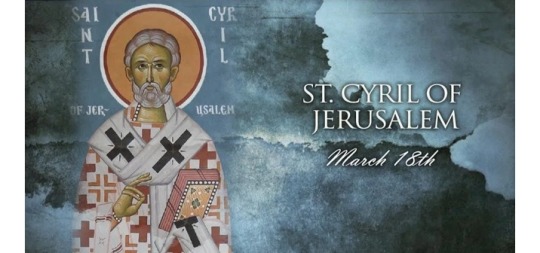
On March 18, the Roman Catholic Church honors St. Cyril of Jerusalem, a fourth-century bishop and Doctor of the Church whose writings are still regarded as masterful expressions of Christian faith.
St. Cyril is also remembered for his exhaustive Biblical knowledge and his endurance in the face of misunderstanding and opposition.
Eastern Catholics and Eastern Orthodox Christians, who likewise celebrate him as a saint on March 18, also remember him on May 7 — the date of a miraculous apparition said to have occurred soon after his consecration as a bishop.
What we know of Cyril's life is gathered from information concerning him from his younger contemporaries — Epiphanius, Jerome and Rufinus, as well as from fifth-century historians — Socrates, Sozomen and Theodoret.
Cyril was most likely born in Jerusalem around the year 315, shortly after the legalization of Christianity throughout the Roman Empire.
Although that legalization put a stop to many of the persecutions that threatened the Church for two centuries, it indirectly gave rise to a number of internal controversies — both in regard to theology and the jurisdiction of bishops in which Cyril would find himself involved.
Cyril received an excellent education in classical Greek literature as well as the Bible.
He was ordained to the priesthood by Bishop Maximus of Jerusalem and succeeded him as bishop in 348.
During his early years as a bishop, most likely around 350, he delivered a series of lectures to new initiates of the Catholic Church.
Twenty-four of the lectures have survived and are studied today.
In a 2007 general audience, Pope Benedict XVI praised the saint for providing an “integral form of Christian instruction involving body, soul, and spirit.”
"St. Cyril's teaching," the Pope said, remains emblematic for the catechetical formation of Christians today."
In 351, three years after Cyril became the Bishop of Jerusalem, a large cross-shaped light appeared for several hours in the sky over the city — an event that many interpreted as a sign of the Church's triumph over heresy.
It could also, however, be understood as a sign of the suffering the new bishop would undergo in leading his flock.
Unlike many other Eastern bishops and priests of the fourth century, Cyril did not allow his classical learning to lead him away from believing in the full humanity and divinity of Christ.
However, the man who consecrated Cyril as a bishop, Archbishop Acacius of Caesarea, was an ally of the Arians who claimed that Jesus was a creature and not God.
Because of his connection to the archbishop, Cyril himself was unjustly suspected of heresy by many of his brother bishops.
But he also found himself at odds with Archbishop Acacius, who claimed to have jurisdiction over the birthplace of the Church.
Altogether, these disputes led to Cyril being exiled from Jerusalem three times in the course of 20 years.
Cyril first took refuge with Silvanus, Bishop of Taraus. He appeared at the Council of Seleucia in 359 in which the semi-Arian party was triumphant.
Acacius was deposed and Cyril seems to have returned to his see. But the emperor was displeased at the turn of events.
In 360, Cyril and other moderates were again driven out and only returned at the accession of Julian in 361.
In 367, a decree of Valens banished all the bishops who had been restored by Julian, and Cyril remained in exile until the death of the persecutor in 378.
In 380, St. Gregory of Nyssa came to Jerusalem on the recommendation of a council held at Antioch in the preceding year.
He found the Faith in accordance with the truth and expressed admiration of his pastoral efforst, but the city was a prey to parties and corrupt in morals.
In 381, Cyril participated in the Second Ecumenical Council, which condemned two different forms of Arianism and added statements about the Holy Spirit to the Nicene Creed of 325.
Cyril of Jerusalem died in 387. He was named a Doctor of the Church by Pope Leo XIII in 1883.
4 notes
·
View notes
Text
Events 7.18 (before 1950)
477 BC – Battle of the Cremera as part of the Roman–Etruscan Wars. Veii ambushes and defeats the Roman army. 387 BC – Roman-Gaulish Wars: Battle of the Allia: A Roman army is defeated by raiding Gauls, leading to the subsequent sacking of Rome. 362 – Roman–Persian Wars: Emperor Julian arrives at Antioch with a Roman expeditionary force (60,000 men) and stays there for nine months to launch a campaign against the Persian Empire. 452 – Sack of Aquileia: After an earlier defeat on the Catalaunian Plains, Attila lays siege to the metropolis of Aquileia and eventually destroys it. 645 – Chinese forces under general Li Shiji besiege the strategic fortress city of Anshi (Liaoning) during the Goguryeo–Tang War. 1195 – Battle of Alarcos: Almohad forces defeat the Castilian army of Alfonso VIII and force its retreat to Toledo. 1290 – King Edward I of England issues the Edict of Expulsion, banishing all Jews (numbering about 16,000) from England. 1334 – The bishop of Florence blesses the first foundation stone for the new campanile (bell tower) of the Florence Cathedral, designed by the artist Giotto di Bondone. 1389 – France and England agree to the Truce of Leulinghem, inaugurating a 13-year peace, the longest period of sustained peace during the Hundred Years' War. 1507 – In Brussels, Prince Charles I is crowned Duke of Burgundy and Count of Flanders, a year after inheriting the title. 1555 – The College of Arms is reincorporated by Royal charter signed by Queen Mary I of England and King Philip II of Spain. 1723 – Johann Sebastian Bach leads the first performance of his cantata Erforsche mich, Gott, und erfahre mein Herz, BWV 136, in Leipzig on the eighth Sunday after Trinity. 1806 – A gunpowder magazine explosion in Birgu, Malta, kills around 200 people. 1812 – The Treaties of Orebro end both the Anglo-Russian and Anglo-Swedish Wars. 1841 – Coronation of Emperor Pedro II of Brazil. 1857 – Louis Faidherbe, French governor of Senegal, arrives to relieve French forces at Kayes, effectively ending El Hajj Umar Tall's war against the French. 1862 – First ascent of Dent Blanche, one of the highest summits in the Alps. 1863 – American Civil War: Second Battle of Fort Wagner: One of the first formal African American military units, the 54th Massachusetts Volunteer Infantry, supported by several white regiments, attempts an unsuccessful assault on Confederate-held Battery Wagner. 1870 – The First Vatican Council decrees the dogma of papal infallibility. 1872 – The Ballot Act 1872 in the United Kingdom introduced the requirement that parliamentary and local government elections be held by secret ballot. 1914 – The U.S. Congress forms the Aviation Section, U.S. Signal Corps, giving official status to aircraft within the U.S. Army for the first time. 1925 – Adolf Hitler publishes Mein Kampf. 1942 – World War II: During the Beisfjord massacre in Norway, 15 Norwegian paramilitary guards help members of the SS to kill 288 political prisoners from Yugoslavia. 1942 – The Germans test fly the Messerschmitt Me 262 using its jet engines for the first time. 1944 – World War II: Hideki Tōjō resigns as Prime Minister of Japan because of numerous setbacks in the war effort.
1 note
·
View note
Text
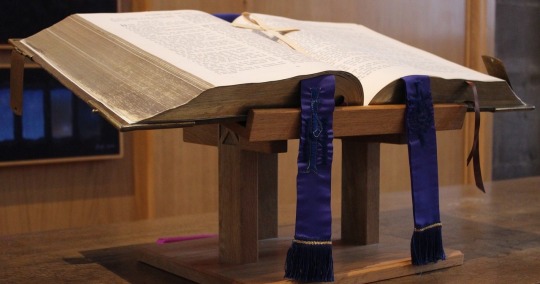
2nd August >> Mass Readings (USA)
Wednesday, Seventeenth Week in Ordinary Time
or
Saint Eusebius of Vercelli, Bishop
or
Saint Peter Julian Eymard.
Wednesday, Seventeenth Week in Ordinary Time
(Liturgical Colour: Green: A (1))
First Reading Exodus 34:29-35 Seeing the face of Moses, they were afraid to come near him.
As Moses came down from Mount Sinai with the two tablets of the commandments in his hands, he did not know that the skin of his face had become radiant while he conversed with the LORD. When Aaron, then, and the other children of Israel saw Moses and noticed how radiant the skin of his face had become, they were afraid to come near him. Only after Moses called to them did Aaron and all the rulers of the community come back to him. Moses then spoke to them. Later on, all the children of Israel came up to him, and he enjoined on them all that the LORD had told him on Mount Sinai. When he finished speaking with them, he put a veil over his face. Whenever Moses entered the presence of the LORD to converse with him, he removed the veil until he came out again. On coming out, he would tell the children of Israel all that had been commanded. Then the children of Israel would see that the skin of Moses’ face was radiant; so he would again put the veil over his face until he went in to converse with the LORD.
The Word of the Lord
R/ Thanks be to God.
Responsorial Psalm Psalm 99:5, 6, 7, 9
R/ Holy is the Lord our God.
Extol the LORD, our God, and worship at his footstool; holy is he!
R/ Holy is the Lord our God.
Moses and Aaron were among his priests, and Samuel, among those who called upon his name; they called upon the LORD, and he answered them.
R/ Holy is the Lord our God.
From the pillar of cloud he spoke to them; they heard his decrees and the law he gave them.
R/ Holy is the Lord our God.
Extol the LORD, our God, and worship at his holy mountain; for holy is the LORD, our God.
R/ Holy is the Lord our God.
Gospel Acclamation John 15:15b
Alleluia, alleluia. I call you my friends, says the Lord, for I have made known to you all that the Father has told me. Alleluia, alleluia.
Gospel Matthew 13:44-46 He sells all he has and buys that field.
Jesus said to his disciples: “The Kingdom of heaven is like a treasure buried in a field, which a person finds and hides again, and out of joy goes and sells all that he has and buys that field. Again, the Kingdom of heaven is like a merchant searching for fine pearls. When he finds a pearl of great price, he goes and sells all that he has and buys it.”
The Gospel of the Lord
R/ Praise to you, Lord Jesus Christ.
--------------------------------
Saint Eusebius of Vercelli, Bishop
(Liturgical Colour: White: A (1))
(Readings for the memorial)
(There is a choice today between the readings for the ferial day (Wednesday) and those for the memorial. The ferial readings are recommended unless pastoral reasons suggest otherwise)
First Reading 1 John 5:1-5 The victory that conquers the world is our faith.
Beloved: Everyone who believes that Jesus is the Christ is begotten by God, and everyone who loves the Father loves also the one begotten by him. In this way we know that we love the children of God when we love God and obey his commandments. For the love of God is this, that we keep his commandments. And his commandments are not burdensome, for whoever is begotten by God conquers the world. And the victory that conquers the world is our faith. Who indeed is the victor over the world but the one who believes that Jesus is the Son of God?
The Word of the Lord
R/ Thanks be to God.
Responsorial Psalm Psalm 89:2-3, 4-5, 21-22, 25 and 27
R/ For ever I will sing the goodness of the Lord.
The favors of the LORD I will sing forever; through all generations my mouth shall proclaim your faithfulness. For you have said, “My kindness is established forever”; in heaven you have confirmed your faithfulness.
R/ For ever I will sing the goodness of the Lord.
“I have made a covenant with my chosen one, I have sworn to David my servant: Forever will I confirm your posterity and establish your throne for all generations.”
R/ For ever I will sing the goodness of the Lord.
“I have found David, my servant; with my holy oil I have anointed him, That my hand may be always with him, and that my arm may make him strong.”
R/ For ever I will sing the goodness of the Lord.
“My faithfulness and my mercy shall be with him, and through my name shall his horn be exalted. He shall say of me, ‘You are my father, my God, the Rock, my savior.’”
R/ For ever I will sing the goodness of the Lord.
Gospel Acclamation Matthew 5:3
Alleluia, alleluia. Blessed are the poor in spirit, for theirs is the Kingdom of heaven. Alleluia, alleluia.
Gospel Matthew 5:1-12a Rejoice and be glad, for your reward will be great in heaven.
When Jesus saw the crowds, he went up the mountain, and after he had sat down, his disciples came to him. He began to teach them, saying:
“Blessed are the poor in spirit, for theirs is the Kingdom of heaven. Blessed are they who mourn, for they will be comforted. Blessed are the meek, for they will inherit the land. Blessed are they who hunger and thirst for righteousness, for they will be satisfied. Blessed are the merciful, for they will be shown mercy. Blessed are the clean of heart, for they will see God. Blessed are the peacemakers, for they will be called children of God. Blessed are they who are persecuted for the sake of righteousness, for theirs is the Kingdom of heaven. Blessed are you when they insult you and persecute you and utter every kind of evil against you falsely because of me. Rejoice and be glad, for your reward will be great in heaven.”
The Gospel of the Lord
R/ Praise to you, Lord Jesus Christ.
-----------------------------------------
Saint Peter Julian Eymard
(Liturgical Colour: White: A (1))
(Readings for the memorial)
(There is a choice today between the readings for the ferial day (Wednesday) and those for the memorial. The ferial readings are recommended unless pastoral reasons suggest otherwise)
First Reading Acts of the Apostles 4:32-35 The community of believers was of one heart and mind.
The community of believers was of one heart and mind, and no one claimed that any of his possessions was his own, but they had everything in common. With great power the Apostles bore witness to the resurrection of the Lord Jesus, and great favor was accorded them all. There was no needy person among them, for those who owned property or houses would sell them, bring the proceeds of the sale, and put them at the feet of the Apostles, and they were distributed to each according to need.
The Word of the Lord
R/ Thanks be to God.
Responsorial Psalm Psalm 34:2-3, 4-5, 6-7, 8-9, 10-11
R/ Taste and see the goodness of the Lord.
I will bless the LORD at all times; his praise shall be ever in my mouth. Let my soul glory in the LORD; the lowly will hear and be glad.
R/ Taste and see the goodness of the Lord.
Glorify the LORD with me, let us together extol his name. I sought the LORD, and he answered me and delivered me from all my fears.
R/ Taste and see the goodness of the Lord.
Look to him that you may be radiant with joy, and your faces may not blush with shame. When the poor one called out, the LORD heard, and from all his distress he saved him.
R/ Taste and see the goodness of the Lord.
The angel of the LORD encamps around those who fear him, and delivers them. Taste and see how good the LORD is; blessed the man who takes refuge in him.
R/ Taste and see the goodness of the Lord.
Fear the LORD, you his holy ones, for nought is lacking to those who fear him. The great grow poor and hungry; but those who seek the LORD want for no good thing.
R/ Taste and see the goodness of the Lord.
Gospel Acclamation John 15:4a, 5b
Alleluia, alleluia. Remain in me, as I remain in you, says the Lord; whoever remains in me will bear much fruit. Alleluia, alleluia.
Gospel John 15:1-8 Whoever remains in me, and I in him, will bear much fruit.
Jesus said to his disciples: “I am the true vine, and my Father is the vine grower. He takes away every branch in me that does not bear fruit, and everyone that does he prunes so that it bears more fruit. You are already pruned because of the word that I spoke to you. Remain in me, as I remain in you. Just as a branch cannot bear fruit on its own unless it remains on the vine, so neither can you unless you remain in me. I am the vine, you are the branches. Whoever remains in me and I in him will bear much fruit, because without me you can do nothing. Anyone who does not remain in me will be thrown out like a branch and wither; people will gather them and throw them into a fire and they will be burned. If you remain in me and my words remain in you, ask for whatever you want and it will be done for you. By this is my Father glorified, that you bear much fruit and become my disciples.”
The Gospel of the Lord
R/ Praise to you, Lord Jesus Christ.
3 notes
·
View notes
Text
Our Lady of Sorrows - 7th Sorrow: Jesus is Buried
Holy Week, Christian Tradition
Eastern Christianity & Western Christianity Holy Week usually do not align as the former uses the Julian Calendar and the latter uses the Gregorian Calendar.

[Art: Drawings of Christ by Heinrich Hofmann. Colorized]
The 7th sorrow is Jesus being sealed away in a tomb. Mother Mary is never mentioned as apart of this story in canon scripture except for as one of the woman from Galilee in The Gospel of Luke.
"The women who had come with Jesus from Galilee followed Joseph and saw the tomb and how his body was laid in it. Then they went home and prepared spices and perfumes. But they rested on the Sabbath in obedience to the commandment." Luke 23:55-56
Parallel Verses
"Joseph took the body, wrapped it in a clean linen cloth, and placed it in his own new tomb that he had cut out of the rock. He rolled a big stone in front of the entrance to the tomb and went away. Mary Magdalene and the other Mary were sitting there opposite the tomb." — Matthew 27:59-61 NIV
"So Joseph bought some linen cloth, took down the body, wrapped it in the linen, and placed it in a tomb cut out of rock. Then he rolled a stone against the entrance of the tomb. Mary Magdalene and Mary the mother of Joseph saw where he was laid." — Mark 15:46-47 NIV
"Later, Joseph of Arimathea asked Pilate for the body of Jesus. Now Joseph was a disciple of Jesus, but secretly because he feared the Jewish leaders. With Pilate’s permission, he came and took the body away. He was accompanied by Nicodemus, the man who earlier had visited Jesus at night. Nicodemus brought a mixture of myrrh and aloes, about seventy-five pounds. Taking Jesus’ body, the two of them wrapped it, with the spices, in strips of linen. This was in accordance with Jewish burial customs. At the place where Jesus was crucified, there was a garden, and in the garden a new tomb, in which no one had ever been laid. Because it was the Jewish day of Preparation and since the tomb was nearby, they laid Jesus there." John 19:38-42 NIV

I should repeat what I said in the last sorrow about the difference between Christian Tradition and "Sola Scriptura", Bible alone Christianity (in case people don't go read other posts) sorry repeat:
The Seven Sorrows were compiled starting in the 13th century with the 5th Sorrow, and by the 15th century celebrating either 5 or 7 of the Sorrows. This time frame is prior to a wide spread acceptance of "Sola Scriptura", i.e Bible alone holds authority, in the 16th century; which is now held by many Protestants. Christian traditions outside the scriptures are considering important in the Catholic Church, hence why there are councils and papal decrees. And indeed in Eastern Orthodoxy the traditions of The Church (meaning "community of Christians") are inexplicably linked to Christian life and practice, with the idea of scripture-only being essentially heresy.
This also explains why the Stations of The Cross do not match the Gospel accounts strictly, such as Mary meeting Jesus as he carries his cross. Christianity that places emphasis on The Church (meaning the community of Christians, not the actual organization) rather than just the Bible considers Christian philosophers; positions and pronouncements of established Churches (example: Catholic law); the different mass rites; Catholic sacraments & Orthodox mysteries; the stories and miracles of saints; the celebration of feast days; oral traditions; and artistic tradition, to be important informative sources on the entire religion.
The concept of this being a sorrow of Mary despite not mentioned in the Gospels is simply a natural conclusion. As a common phrase "No parent should have to bury a child" or as Rose Kennedy put it " It's wrong for parents to bury their children. It should be the other way around."
Burial of Jesus in the Apocrypha
"[...] and gave his body to Joseph that he might bury it, since he was one who had seen the many good things he did. And having taken the Lord, he washed and tied him with a linen cloth and brought him into his own sepulcher, called the Garden of Joseph." — Gospel of Peter 23ish-24
.▪️.
"But I with the companions was sorrowful; and having been wounded in spirit, we were in hiding, for we were sought after by them as wrongdoers and as wishing to set fire to the sanctuary. In addition to all these things we were fasting; and we were sitting mourning and weeping night and day until the Sabbath." — Gospel of Peter 26-27
If anything "companions was sorrowful" supports this as a Sorrow more than the canonical Gospels.
"And Nicodemus came, bringing with him a mixture of myrrh and aloes about a hundred pound weight; and they took down Jesus from the cross with tears, and bound him with linen cloths with spices, according to the custom of burying among the Jews, And placed him in a new tomb, which Joseph had built, and caused to be cut out of a rock, in which never any man had been put; and they rolled a great stone to the door of the sepulchre." — Gospel of Nicodemus 8:14-15


[Art: Jesus In The Tomb, Illustration For "The Life Of Christ" by James Jacques Tissot]
"I grieve for thee, O Mary most sorrowful, for the pangs that wrenched thy most loving heart at the burial of Jesus. Dear Mother, by thy heart sunk in the bitterness of desolation, obtain for me the virtue of diligence and the gift of wisdom." — Prayer of the Seventh Sorrow, Short Version
🗡️ Notes
• The Seven Sorrows — Link
• I prefer the shorter version of the 7 Sorrows Prayers that I found here — Link
• Divider by @/firefly-graphics — Link
#marian veneration#marian devotion#marian art#marian worship#mother mary#virgin mary#christianity#xtianity#good friday#mariolatry#our lady of sorrows#mater dolorosa#sorrow 7#seventh sorrow#adjacent audience:#christopagan
1 note
·
View note
Text
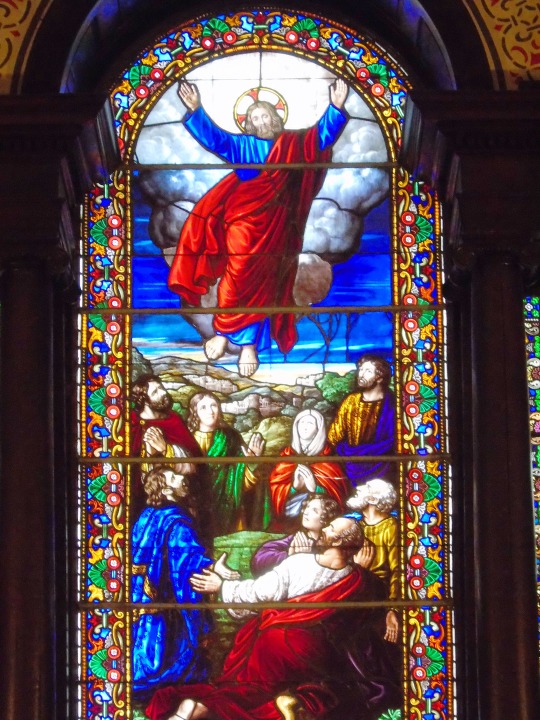
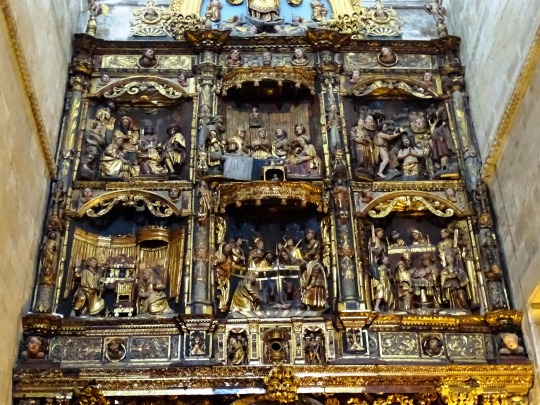
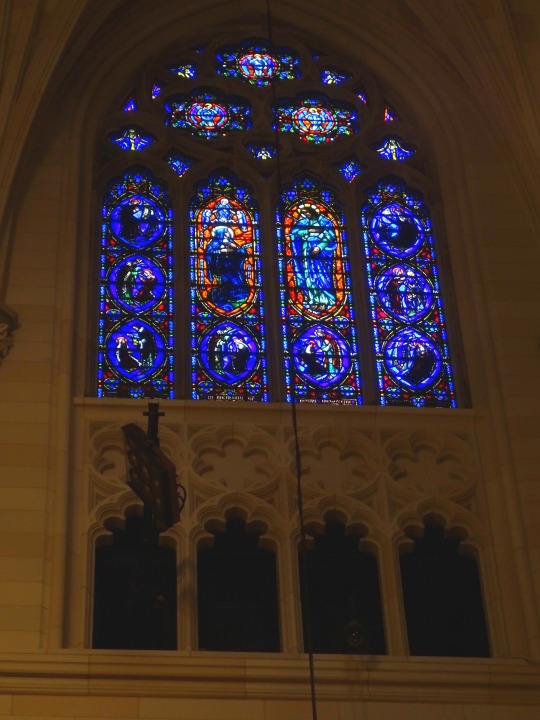
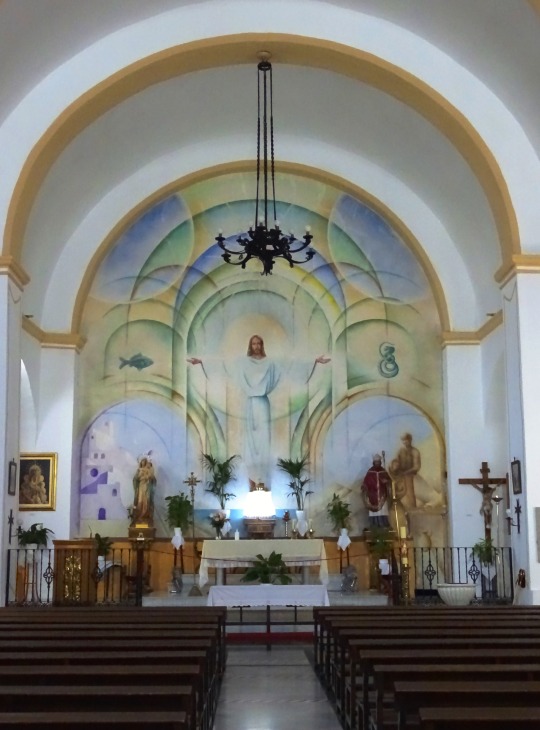
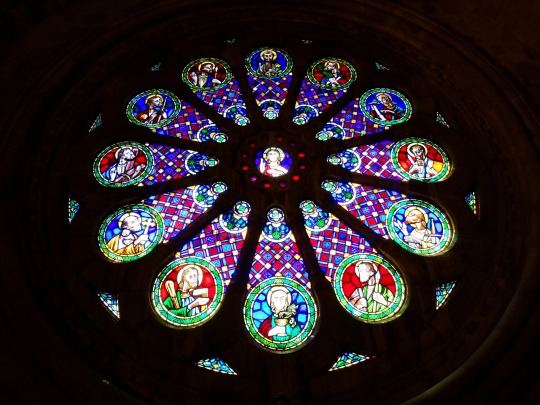
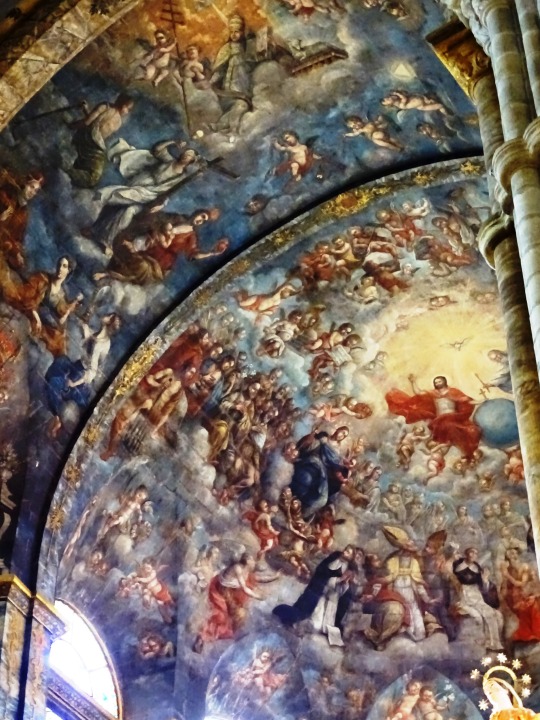
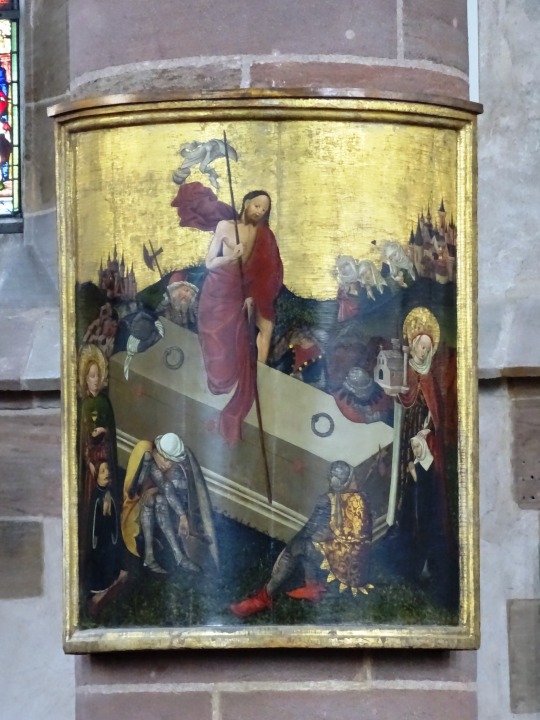
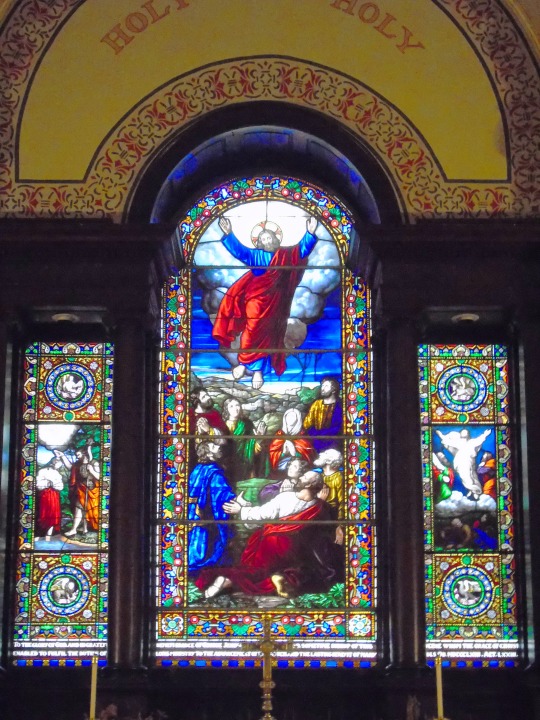

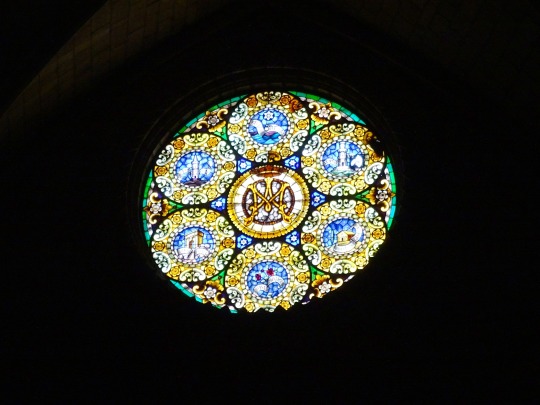

Ascension Day
We commemorate Jesus Christ’s ascension into heaven (as per Christian belief) by celebrating Ascension Day, which occurs on the Thursday, which is 40 (or 39) days after Easter. This year, it will take place on May 9. Known by multiple names — The Feast of the Ascension, The Ascension of Jesus, Ascension Thursday, Holy Thursday, or Solemnity of the Ascension of the Lord — this is a Christian holiday that doubles as a public holiday in many countries like Austria, Belgium, Denmark, Germany, France, Switzerland and more.
History of Ascension Day
One of the earliest Christian festivals, Ascension Day marks the end of the Easter season. This event is celebrated primarily by Catholics and Anglican Christians; most Protestant churches do not follow this tradition anymore. The date, too, differs in different geographic locations. Western Churches prefer to use the Gregorian calendar for calculating this date, while many Eastern Orthodox Churches calculate this date according to the Julian calendar. As a result, their celebrations occur at a later date than the Western event.
As per the New Testament in the Bible, after Jesus Christ’s crucifixion on Good Friday, he was resurrected from the dead in three days, on the day we know as Easter Sunday. For 40 days after this, he stayed with his Apostles (the primary disciples of Christ) to instruct them on how to carry out his teachings. As the Bible says, at the end of day 40, Jesus Christ and his disciples went to Mount Olivet (or the Mount of Olives), near Jerusalem. After asking them to stay, Christ then ascended to heaven to take his seat at the right hand of God, under the gaze of his disciples. To Christians, the ascension signifies that Christ completed his work on Earth and allowed him to prepare a place for his followers in heaven.
Initially a part of Easter celebrations, this day was later separated from Easter, along with Pentecost. Celebration of Pentecost ends the cycle of Easter-related events in the Christian calendar.
Ascension Day timeline
68 A.D. The Tradition Begins
Ascension Day begins to be observed, albeit with two other holidays — Easter Sunday and Pentecost.
300 A.D. Ascension Day Develops As A Separate Tradition
A decree declares this celebration now must be observed separately — it is moved to 40 days after Easter.
385 A.D. First Written Evidence Appears
We see the very first piece of written evidence that the Ascension Day Feast is celebrated.
5th century Ascension Day Starts Appearing In Art
Christian art showcases this holiday.
6th century Art Begins To Reflect Different Versions
Syria develops a different version of the Ascension, which is later adopted by Byzantine art.
18th century Germany Celebrates Father's Day
Ascension Day coincides with Father's Day in Germany — they celebrate Jesus returning to the Holy Father.
19th century Germany Celebrates With Colourful Parades
To replicate the way the Apostles walked with Jesus, Christians begin to host colorful parades as a commemoration.
How To Observe Ascension Day
Go to church
Attend church processions
Listen to hymns
Learn how your local church celebrates this day. Take some time to attend a Mass or Christian church service. Clarify the details before you go, as these services differ based on whether the church is Protestant or Catholic.
Tradition says this holiday is observed by a three-day procession, then the feast itself, which includes a procession of torches and banners to symbolize Christ’s journey to the Mount of Olives and entry into heaven. While your local church might not have such grand festivities, find out if they are still carrying out a procession.
Listening to hymns is a traditional part of Ascension Day celebrations. A medley of these religious songs can have you humming along for days. Even popular artists have been known to hum a hymn or two over the years. Check out Carrie Underwood’s ‘Something In The Water,’ or U2’s ‘Where The Streets Have No Name,’ or even John Legend’s ‘Preach.’
Facts About Ascension Day
In Sweden, people go on early morning walks
The British celebrated by 'beating the willow'
Welsh people don’t work on this day
Portugal celebrates by keeping wheat in their houses
Indonesia has a public holiday on Ascension Day
Many people go out into the woods at 3 AM or 4 AM to hear the birds at sunrise, believing that hearing a cuckoo from the east or west brings them good luck — this activity is called ‘gökotta.’
In the olden days, as young boys were driven along the parish boundaries, they were beaten with willow branches to drive away evil.
It is more than a holiday celebration in Wales — Welsh people believe that it is unlucky to do any work on Ascension Day.
Traditionally, rural Portuguese households keep wheat in their homes throughout the coming year — this day is associated with peace and prosperity and, to them, wheat symbolizes prosperity.
Despite Christianity being a minor religion in Indonesia, Ascension Day is designated as a public holiday.
Why Ascension Day Is Important
It is an opportunity for reflection and to gain inner peace
We learn about Christian traditions
It helps us expand our cultural horizons
Instances, where we can simply sit, reflect, and learn the true meaning of peace, are rare in our busy worlds. This is why we recommend holding onto such chances with both hands. Ascension Day church services center around this theme. If you are not a religious or church person, simply take a moment to sit by yourself and reflect on your journey so far and how you would like to continue. There’s no better way to celebrate this day than by centering yourself and your thoughts.
Expanding our knowledge is good for us. Plus, learning about Ascension Day not only helps us expand our store of general knowledge, but also inspires us to observe some of the traditions.
Such traditions have been prevalent for a long time, and have taken on varying degrees of importance around the world. Even festivities change as per the customs of a certain region. Learning more about these traditions changes our views of cultures and gives us extended knowledge of people from other nations.
Source
#Mojácar Pueblo#Church of Santa Maria#Lisbon Cathedral#Lisbona#interior#stained glass window#Ascension Day#Auffahrt#long weekend#9 May 2024#39 days after Easter#Saint Mary's Cathedral#Lugo Cathedral#Spain#Portugal#Holy Trinity Anglican Cathedral#Québec#Quebec City#Canada#Germany#Stadtpfarrkirche Unserer Lieben Frau#Nuremberg#Nürnberg#Solsona Cathedral#St. Patrick's Cathedral#Manhattan#New York City#USA#architecture#original photography
11 notes
·
View notes